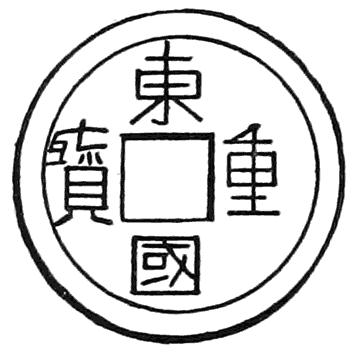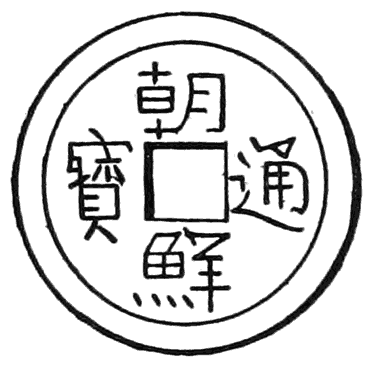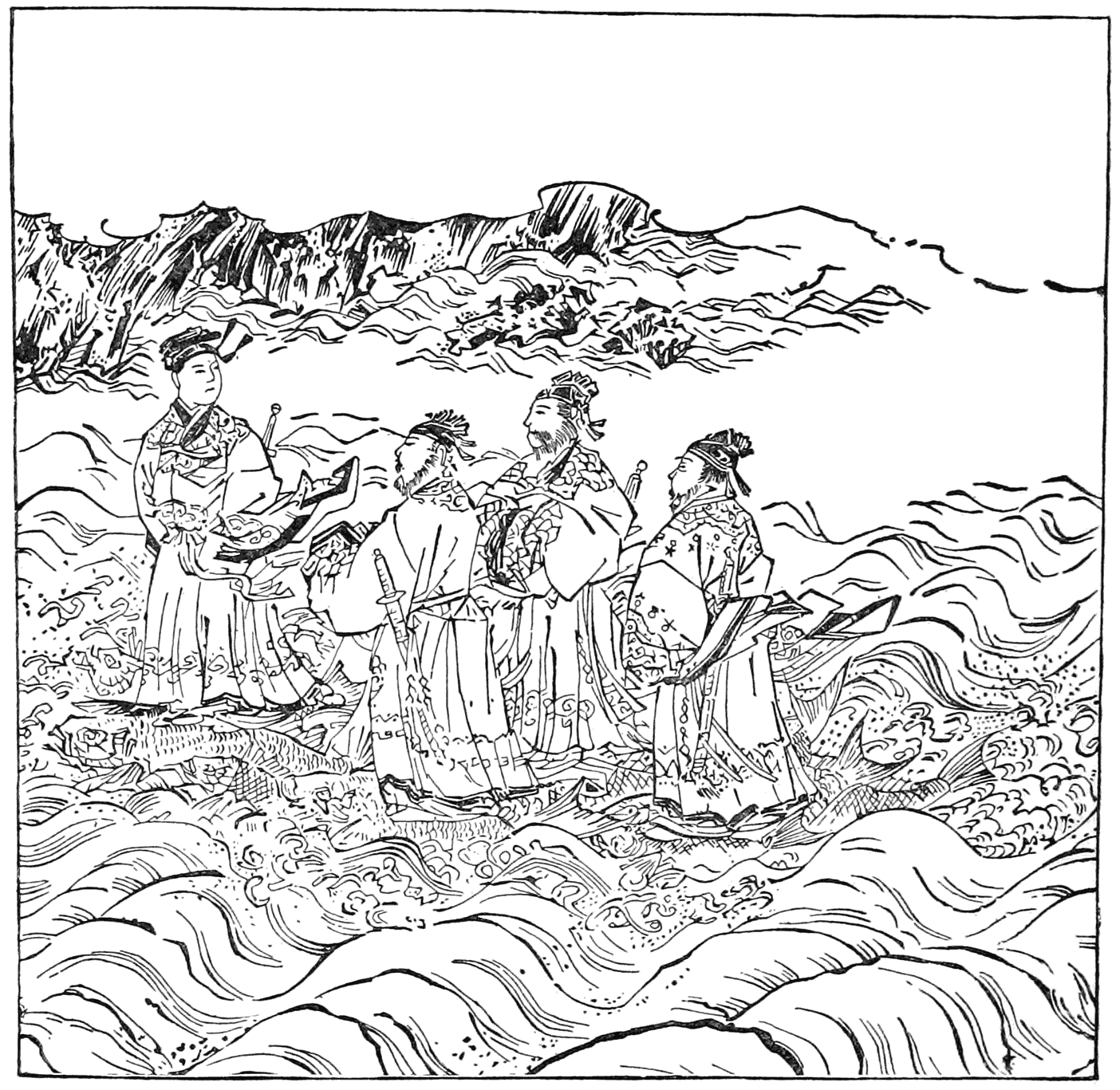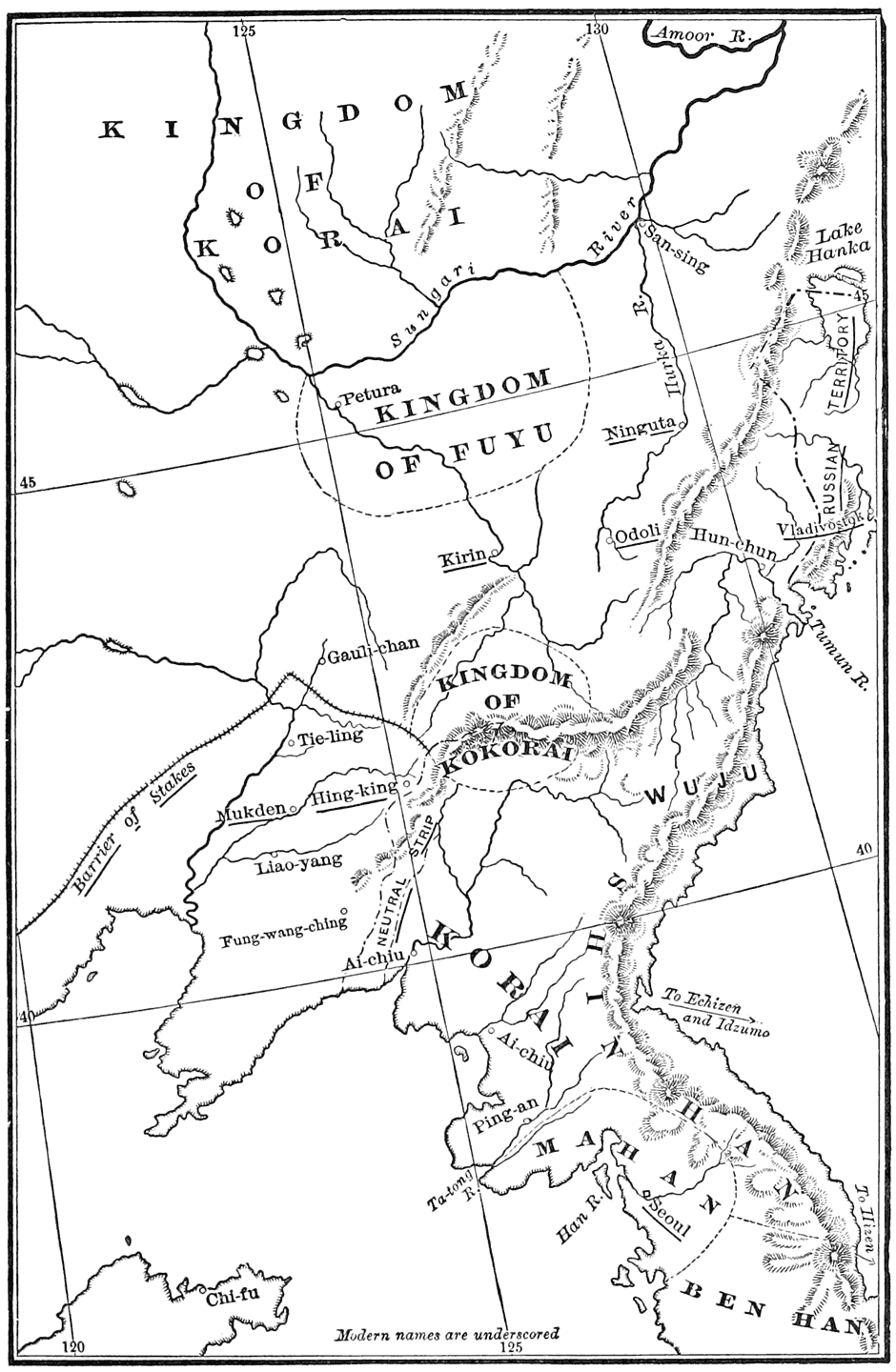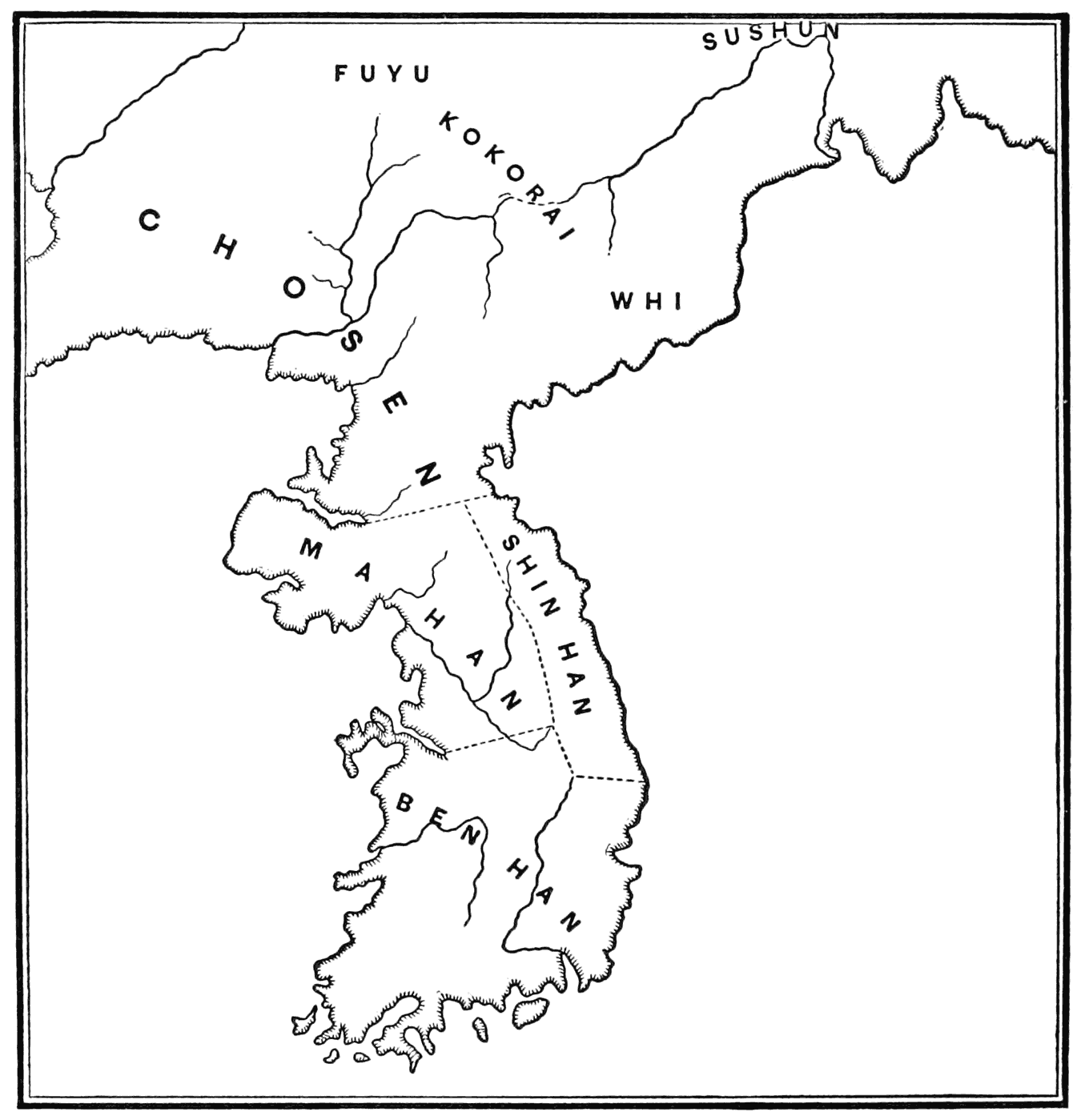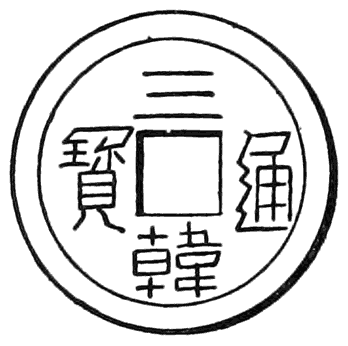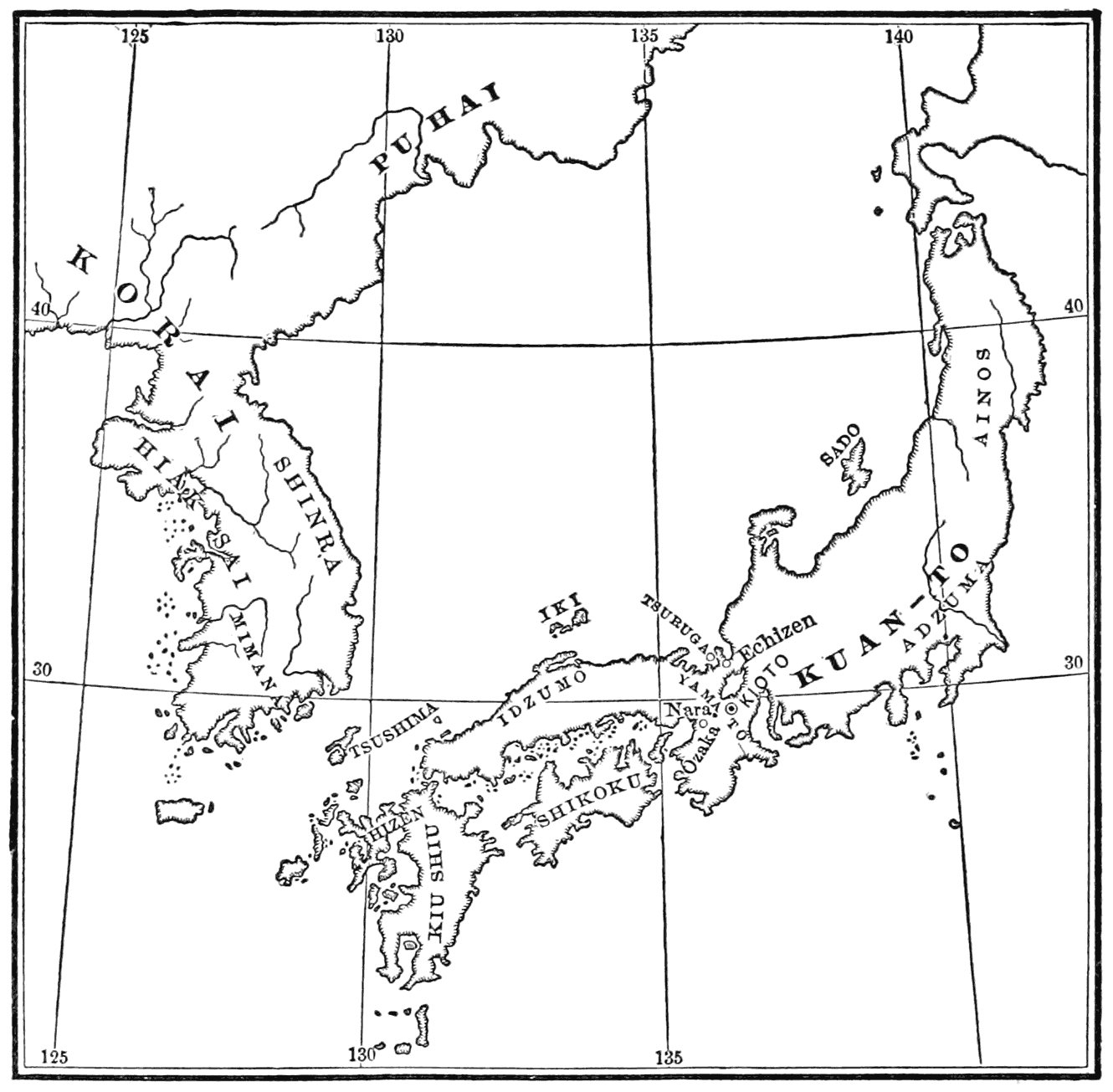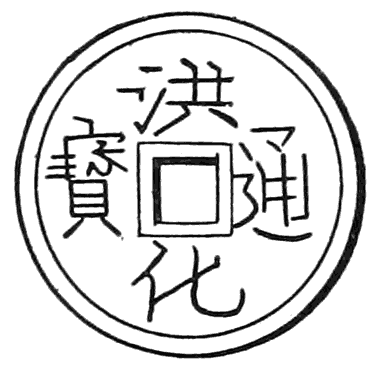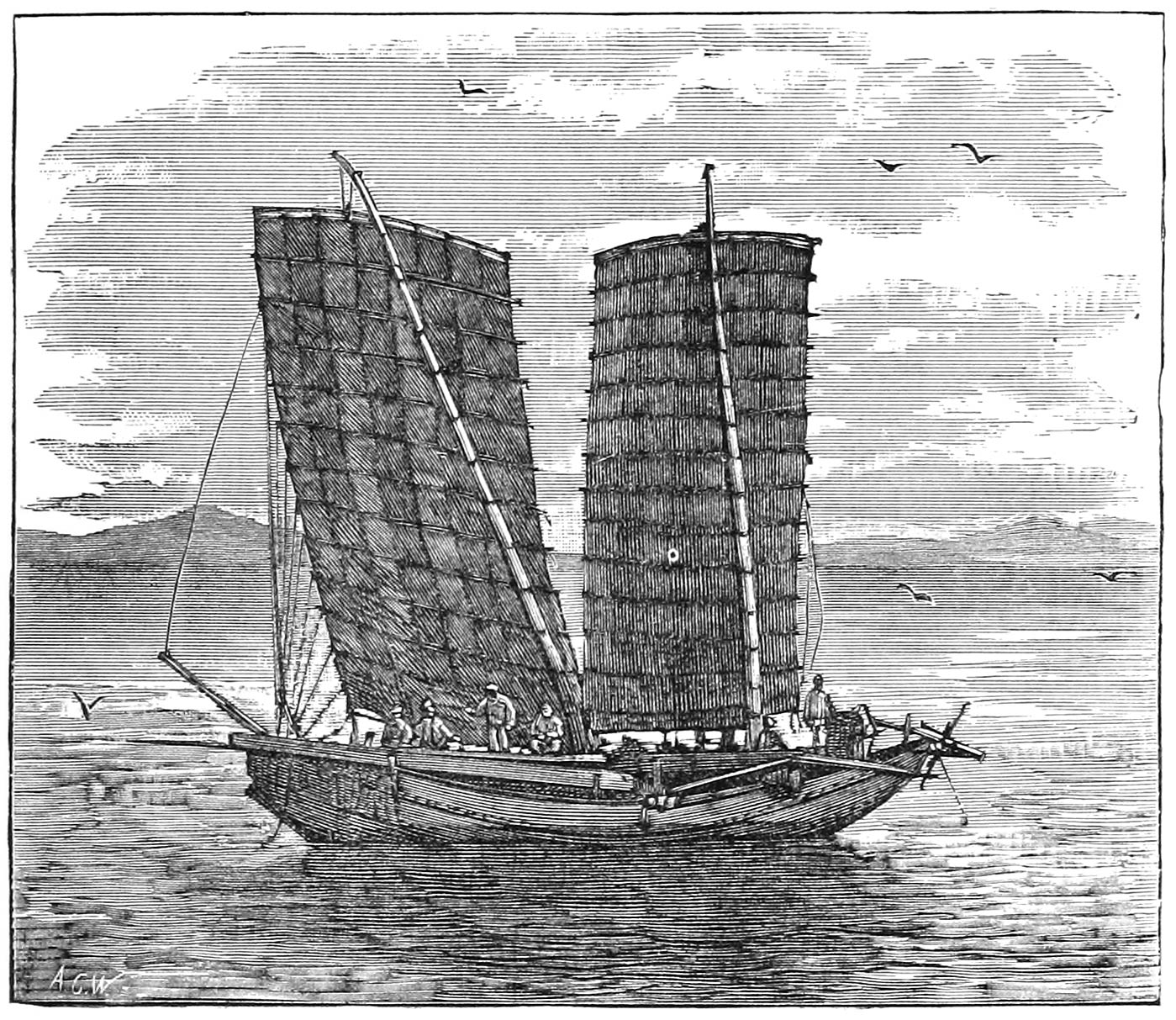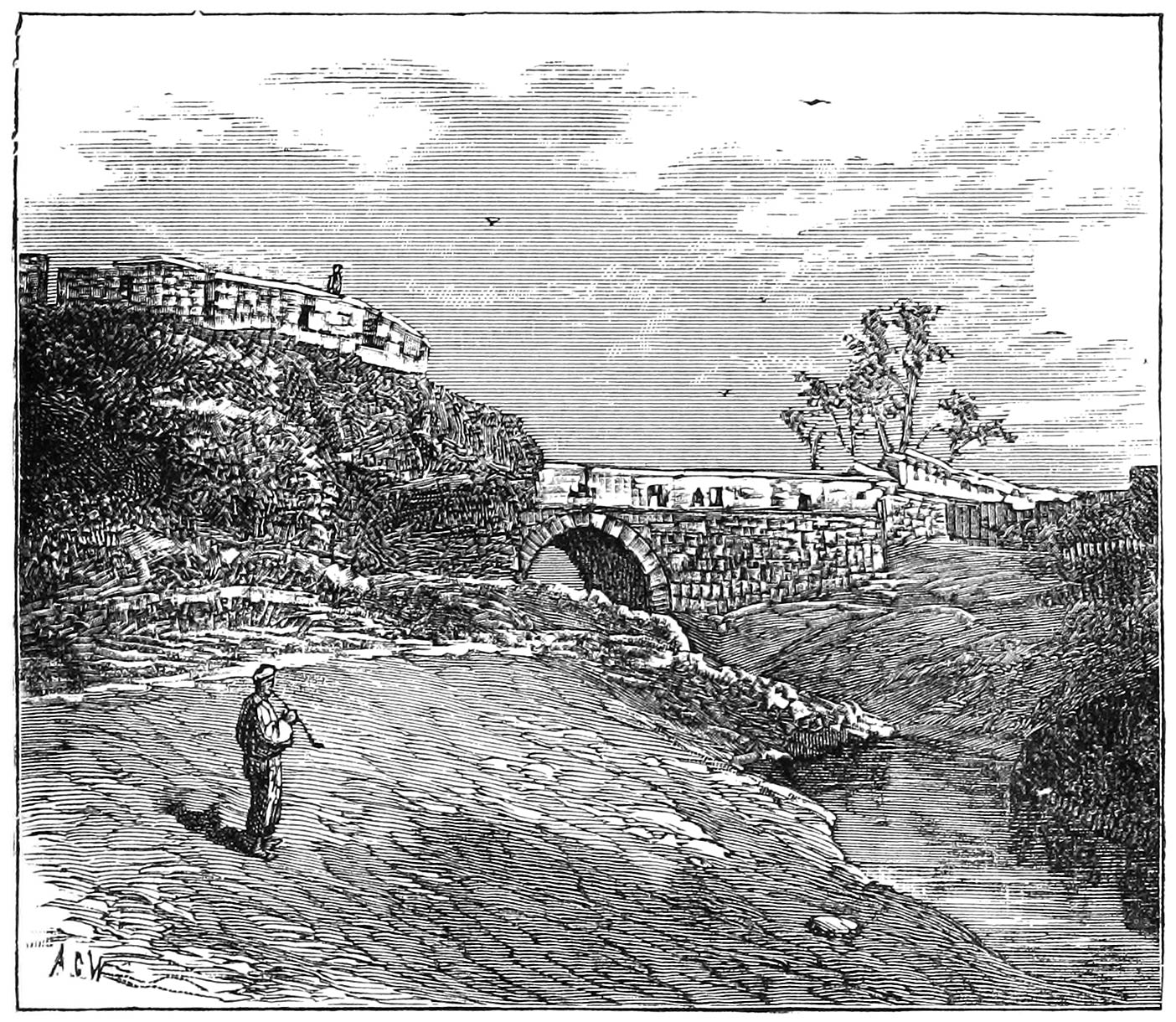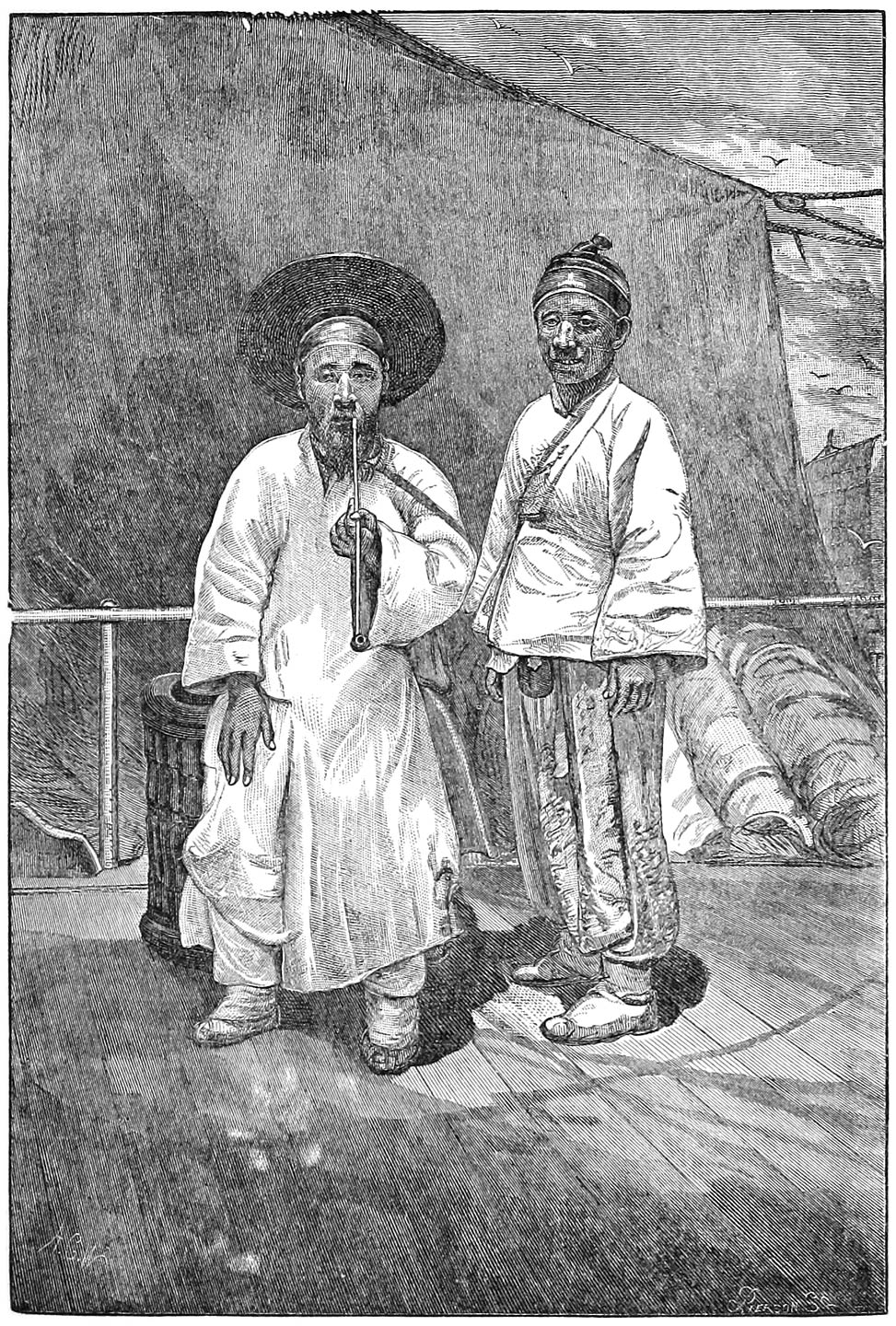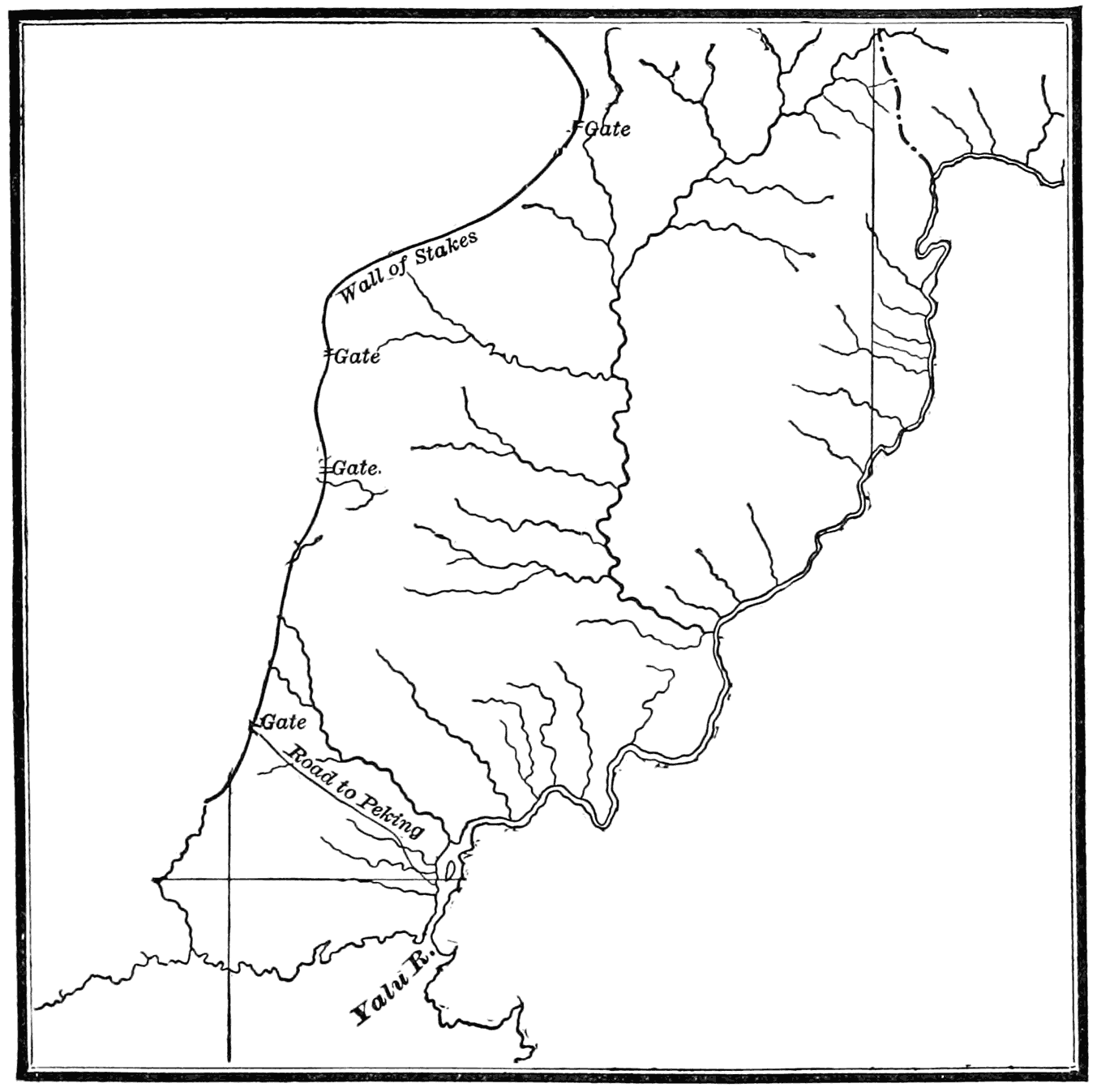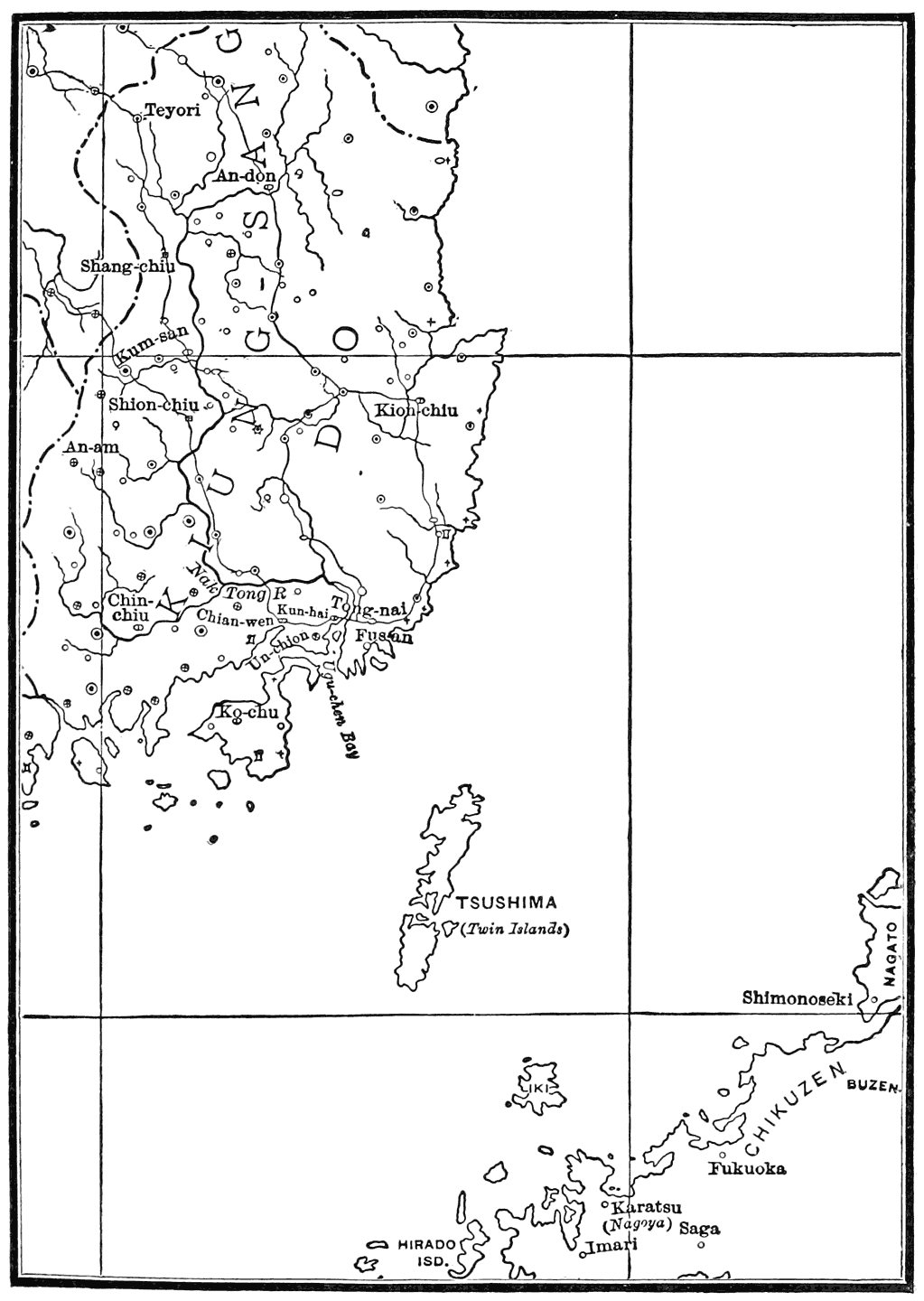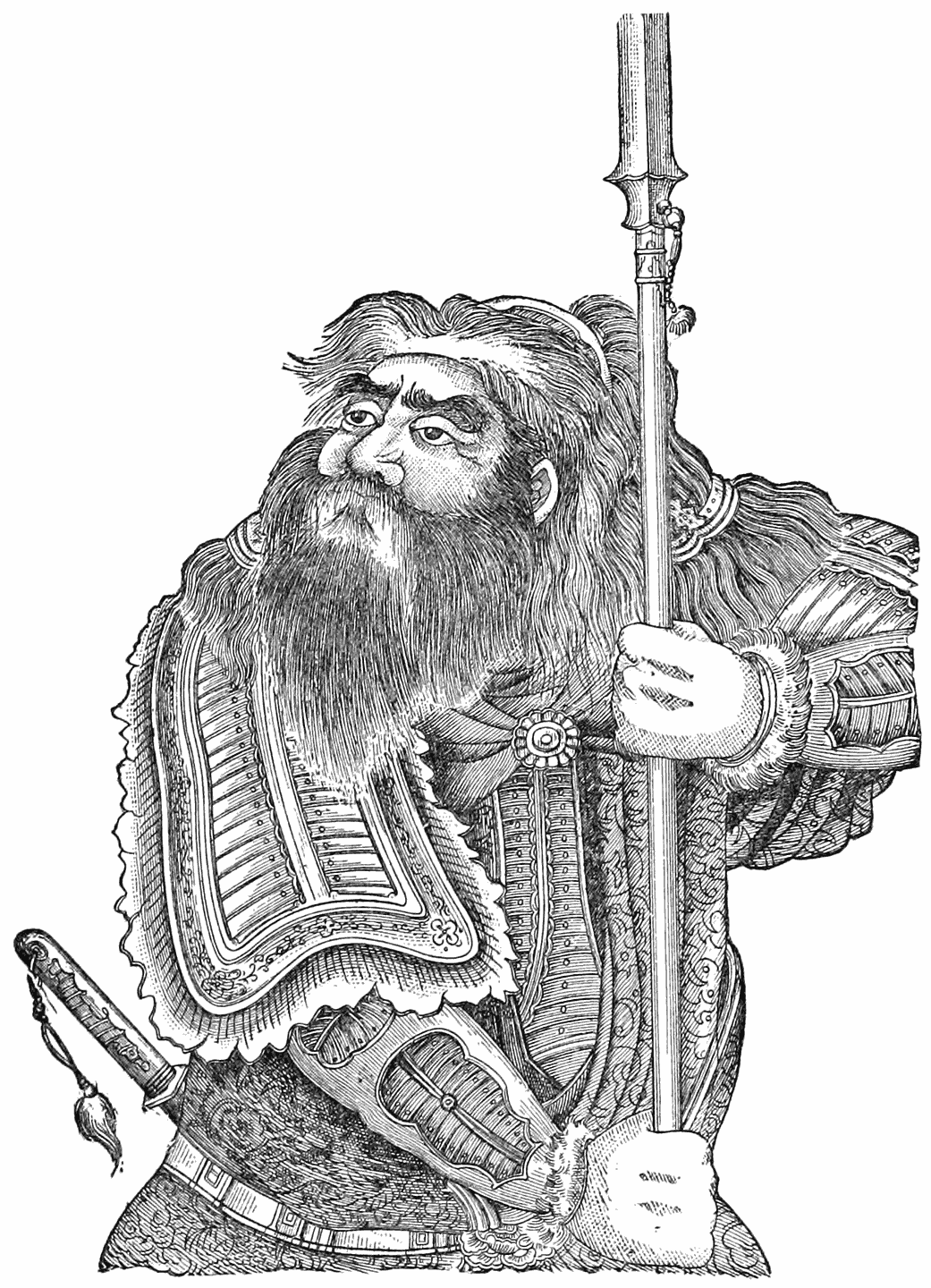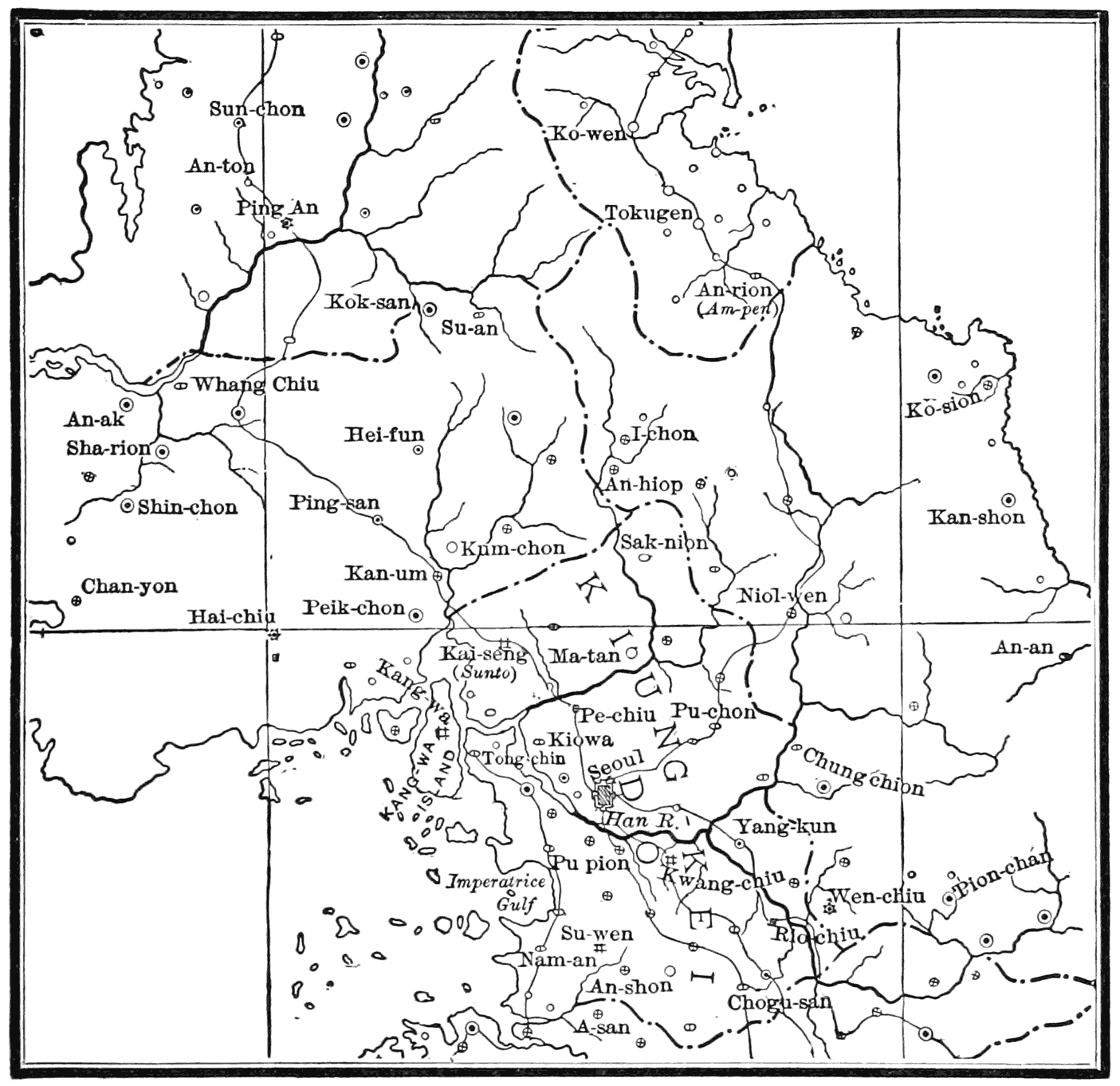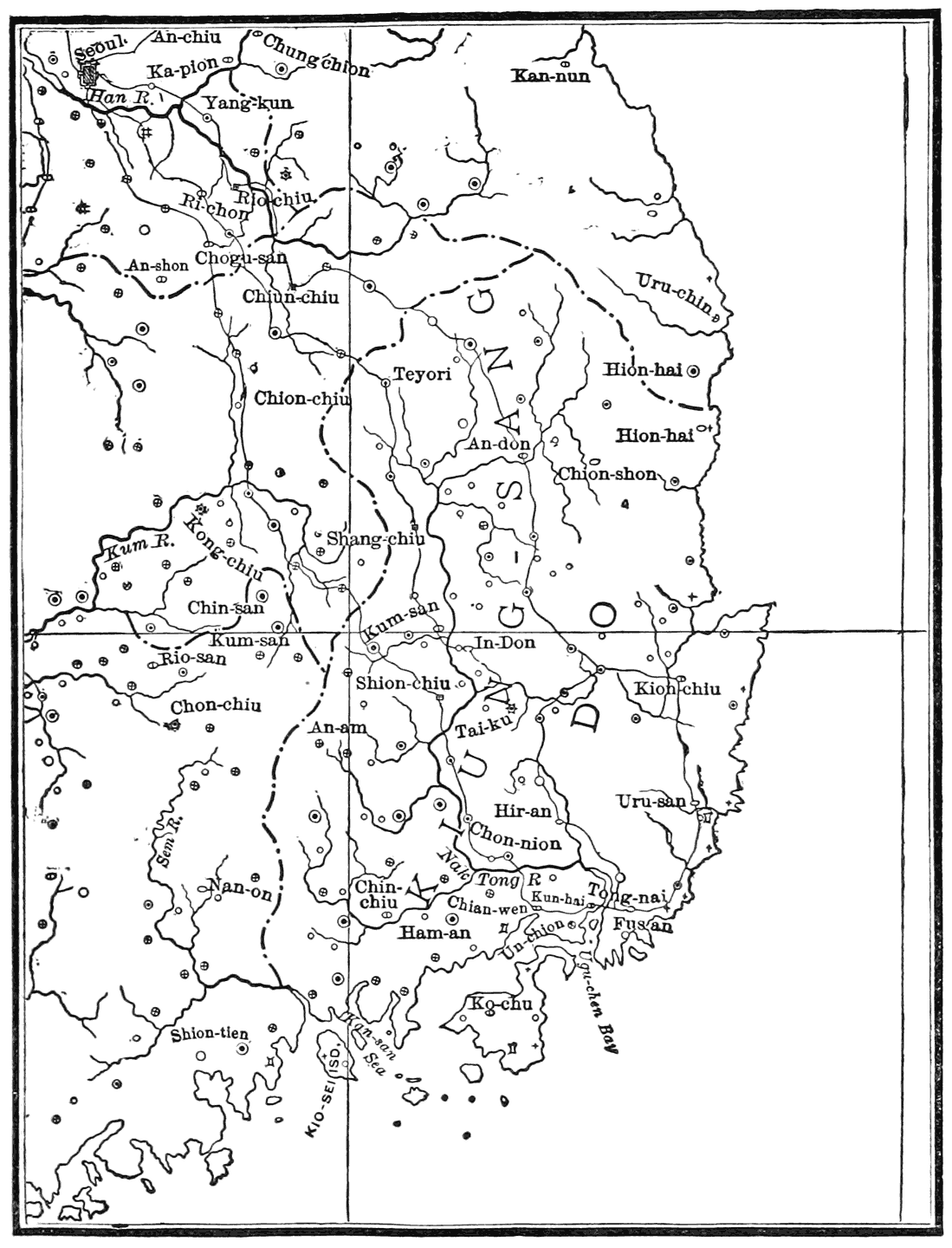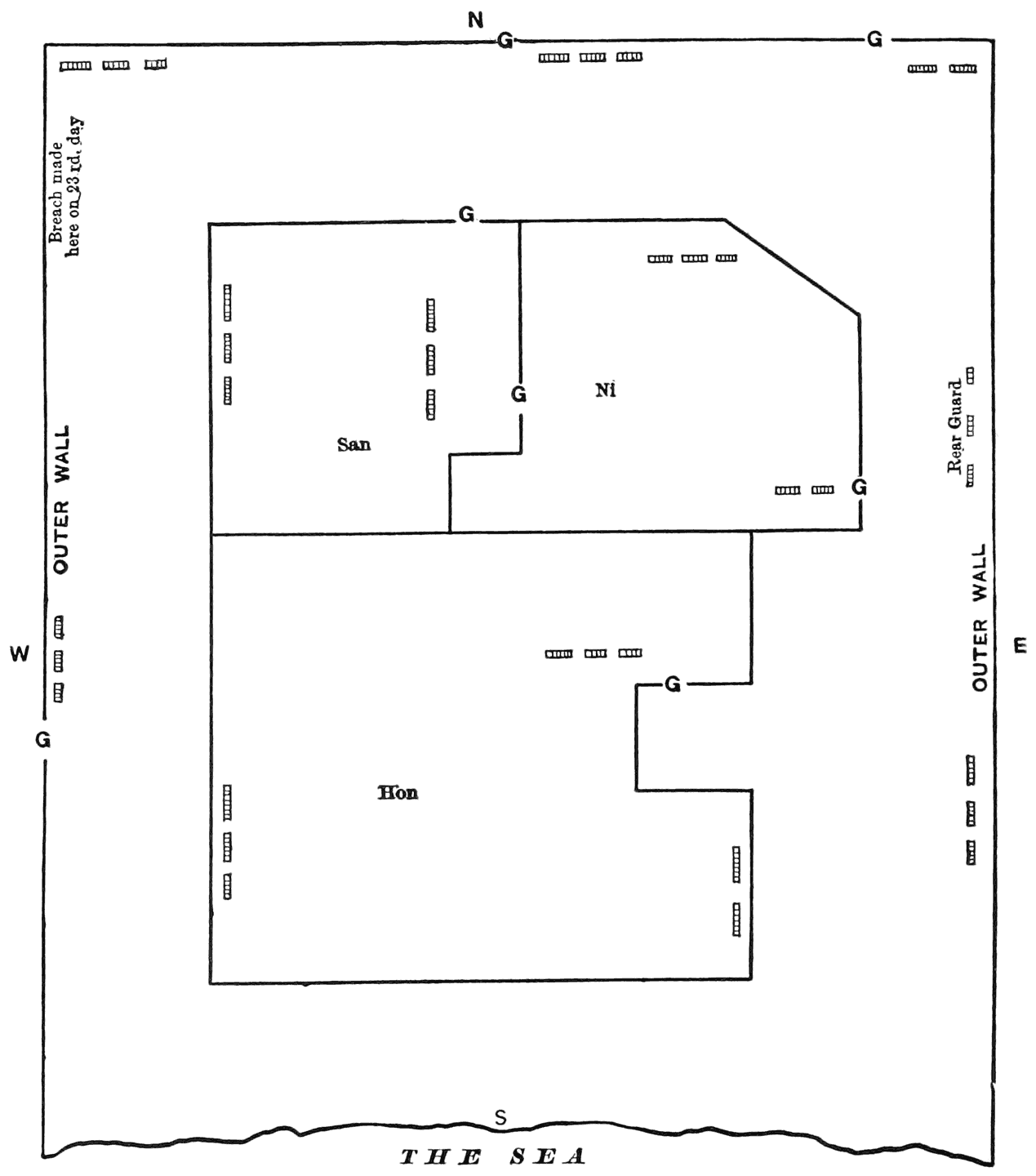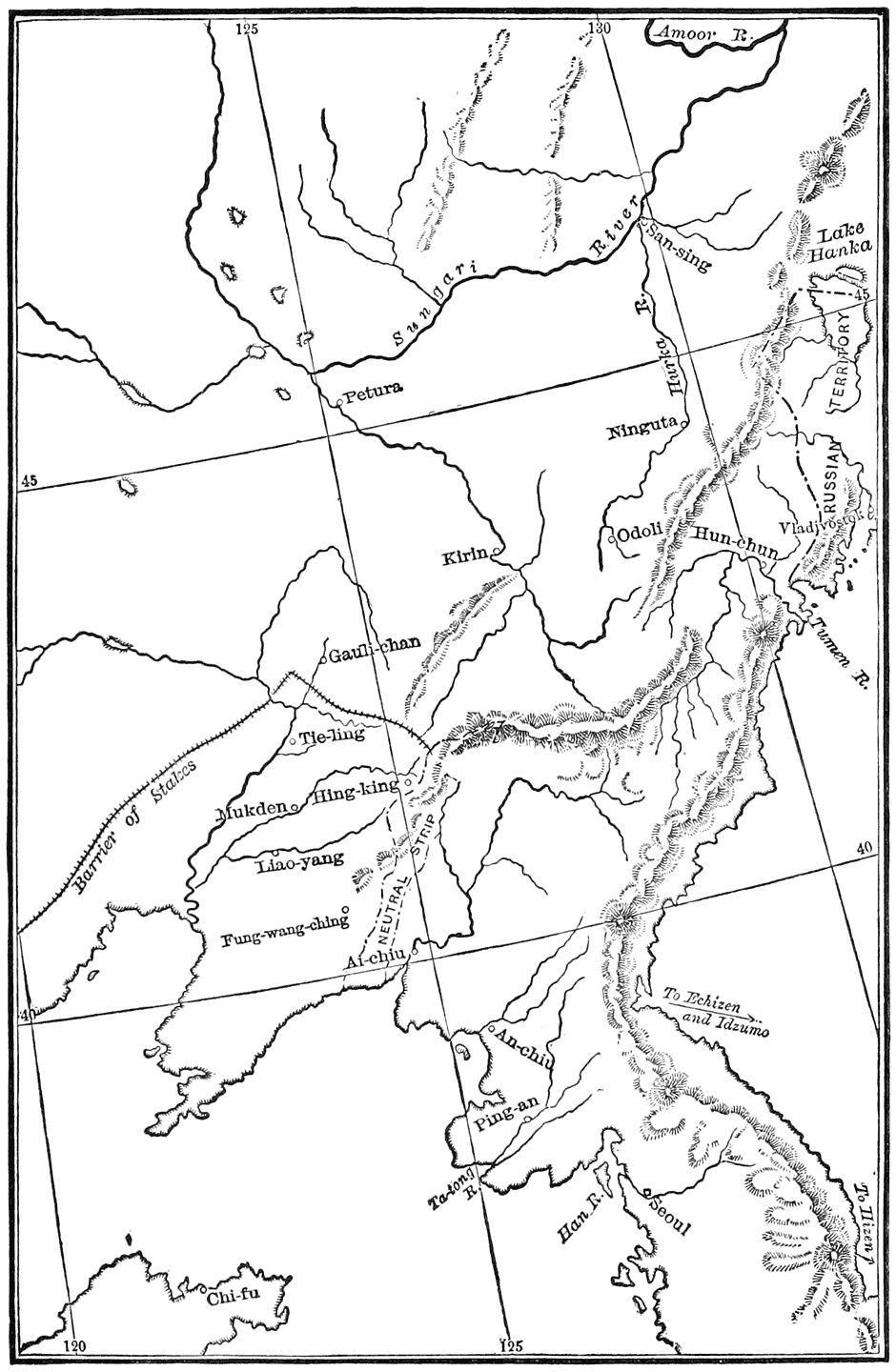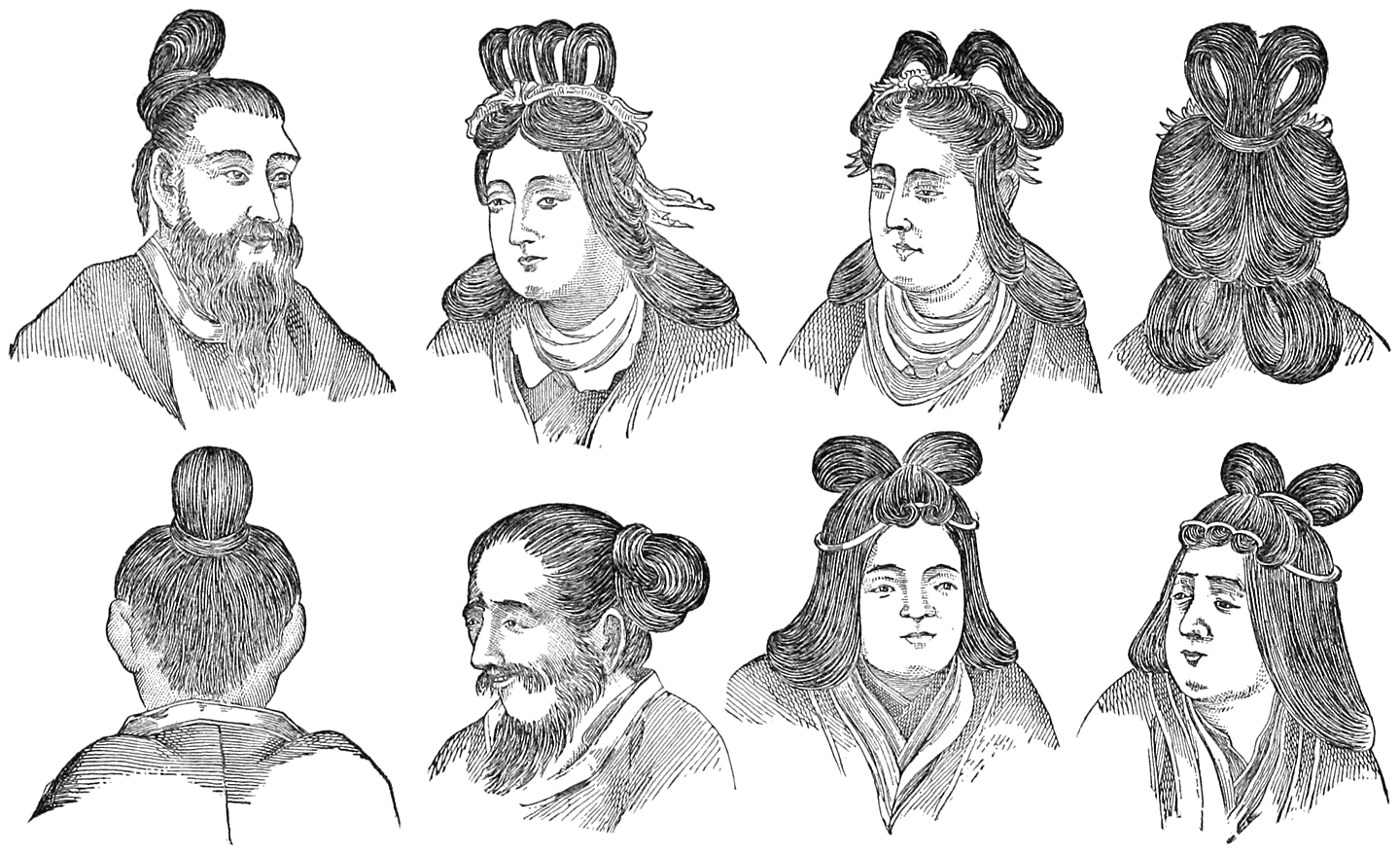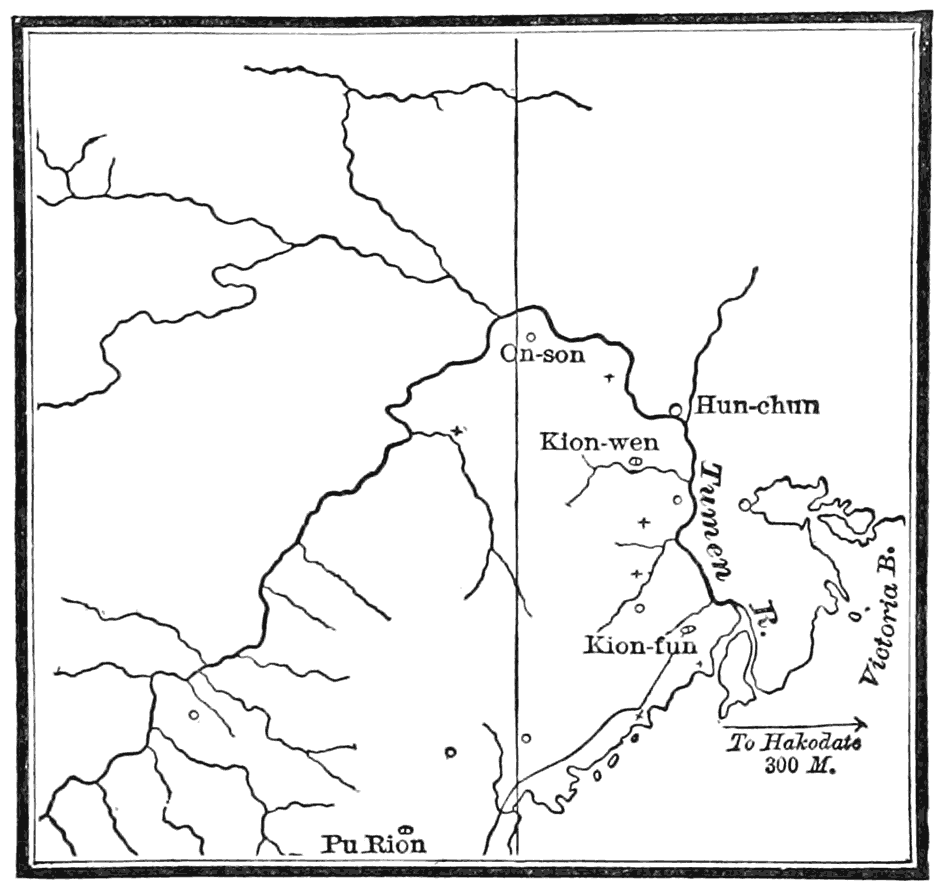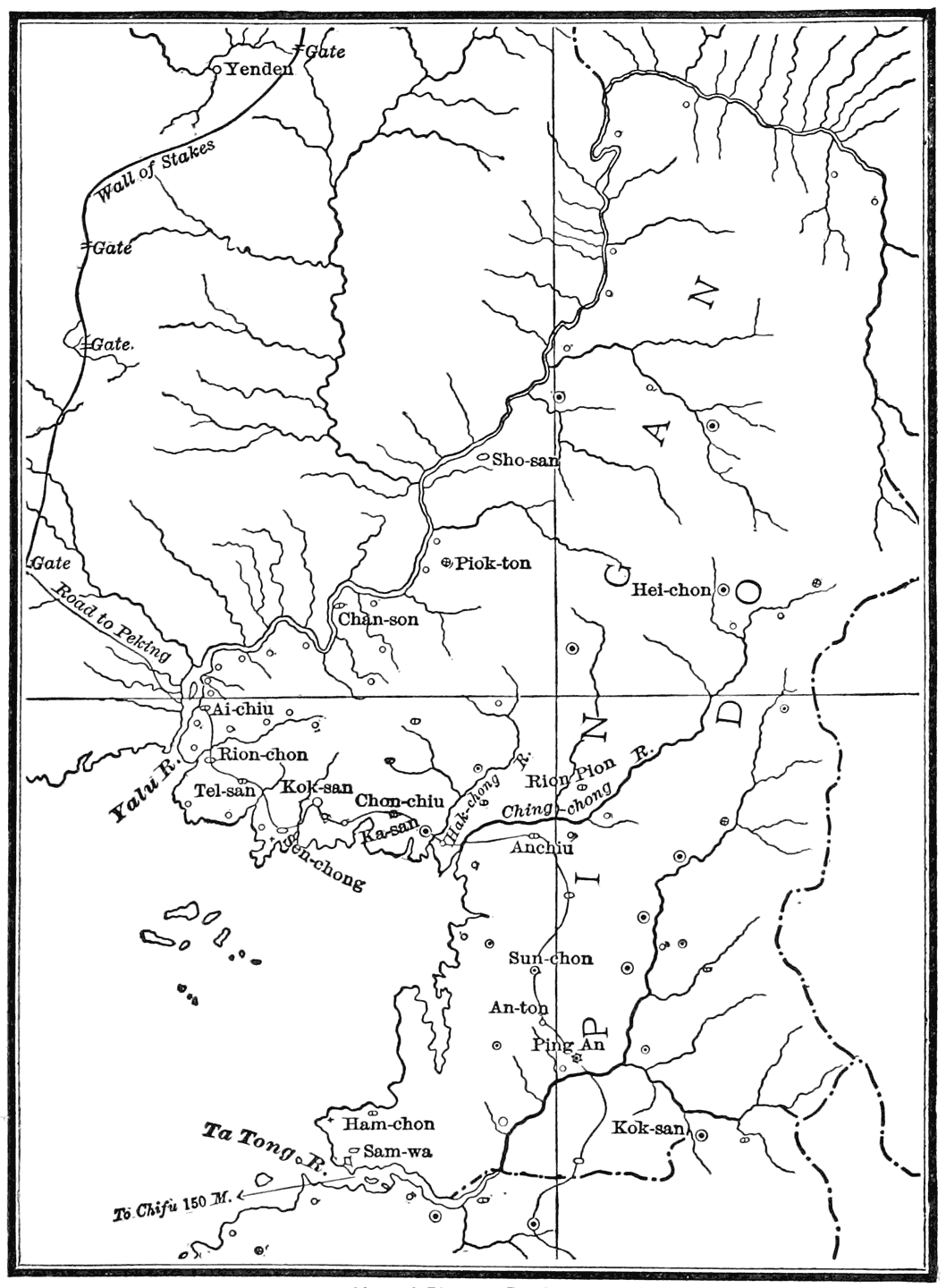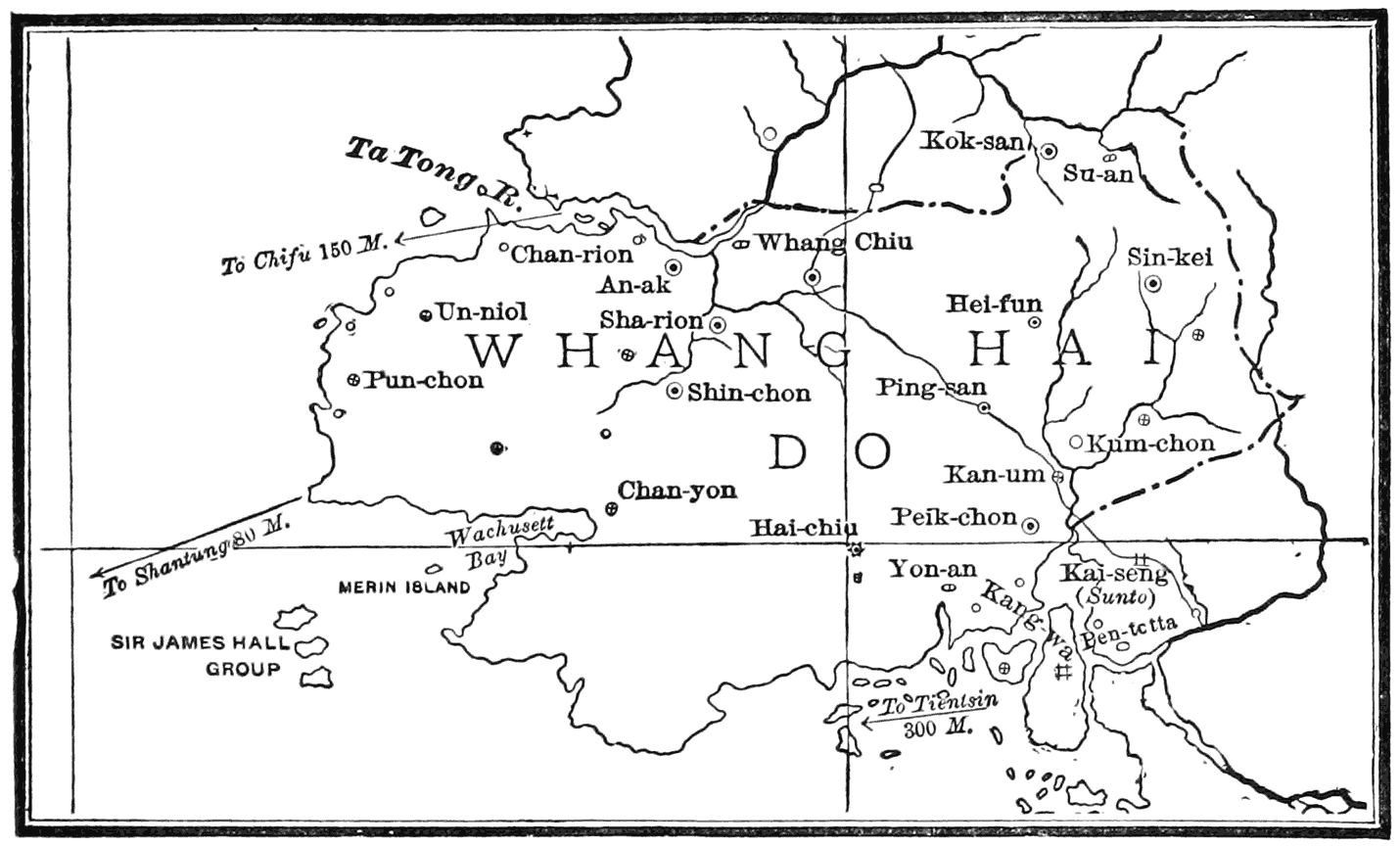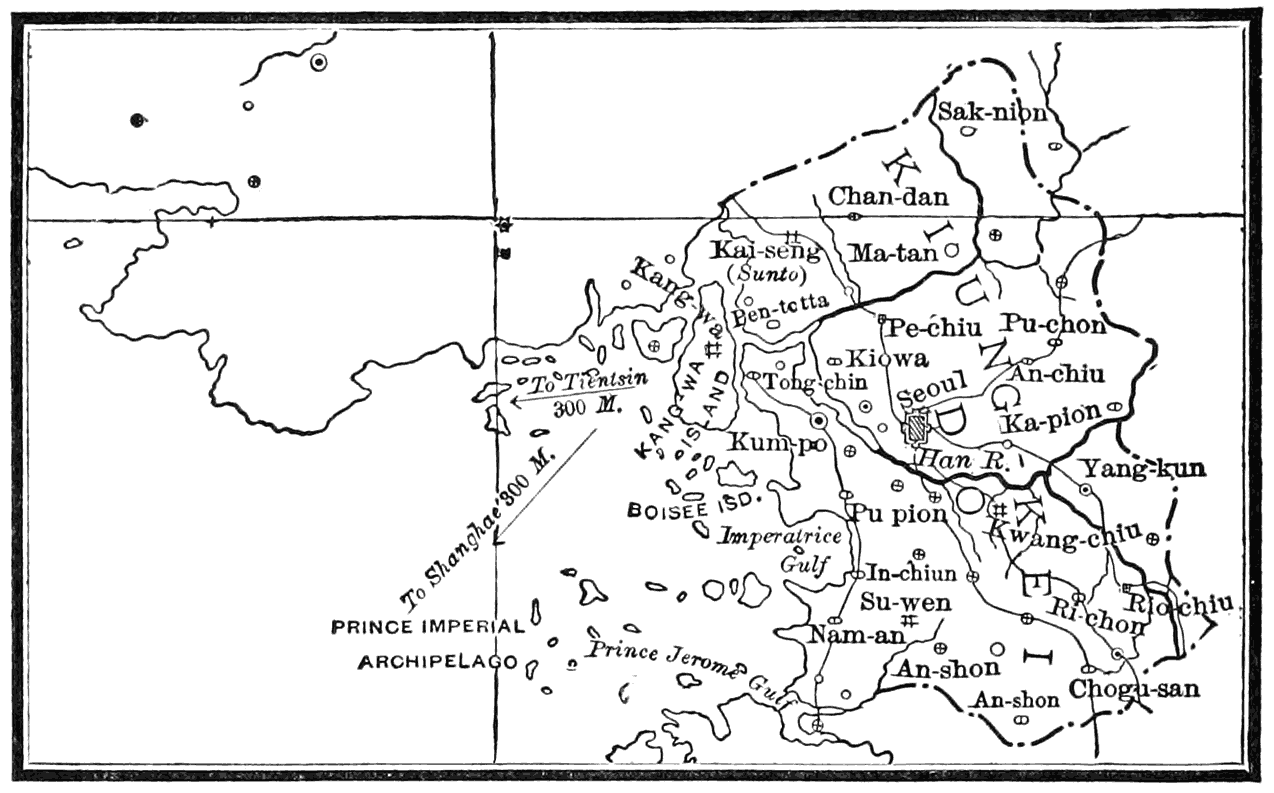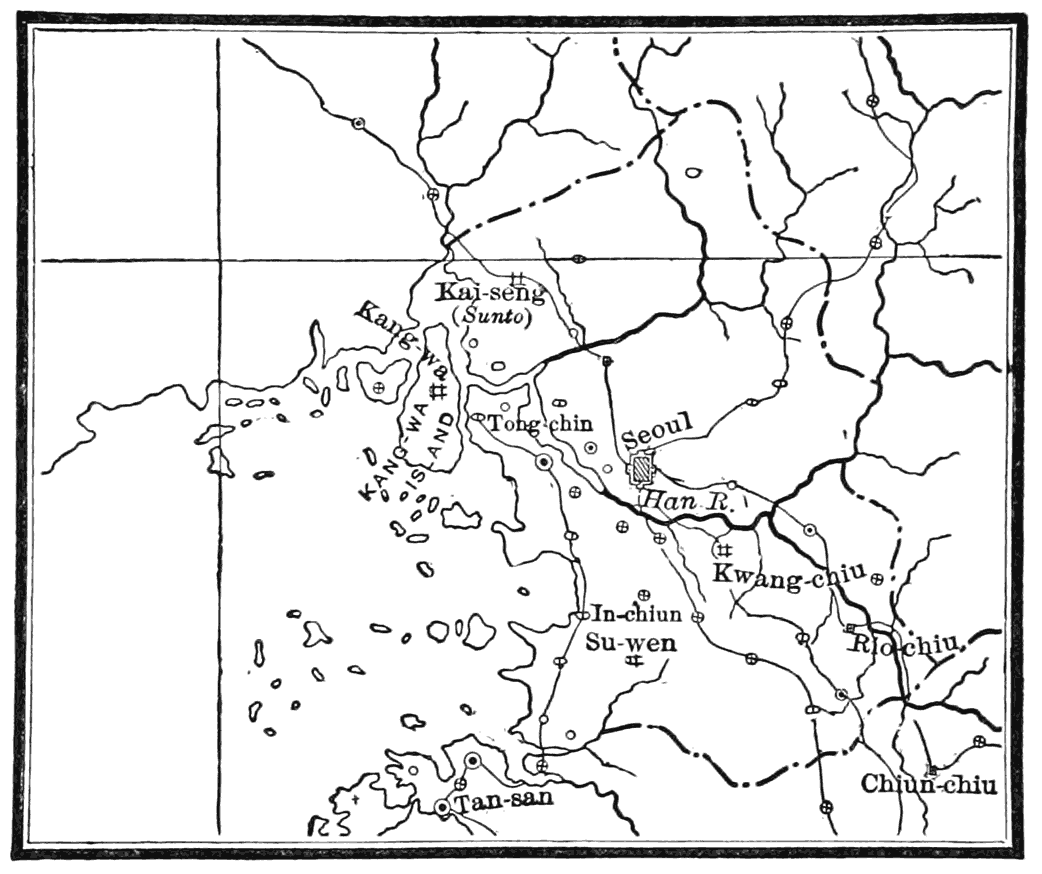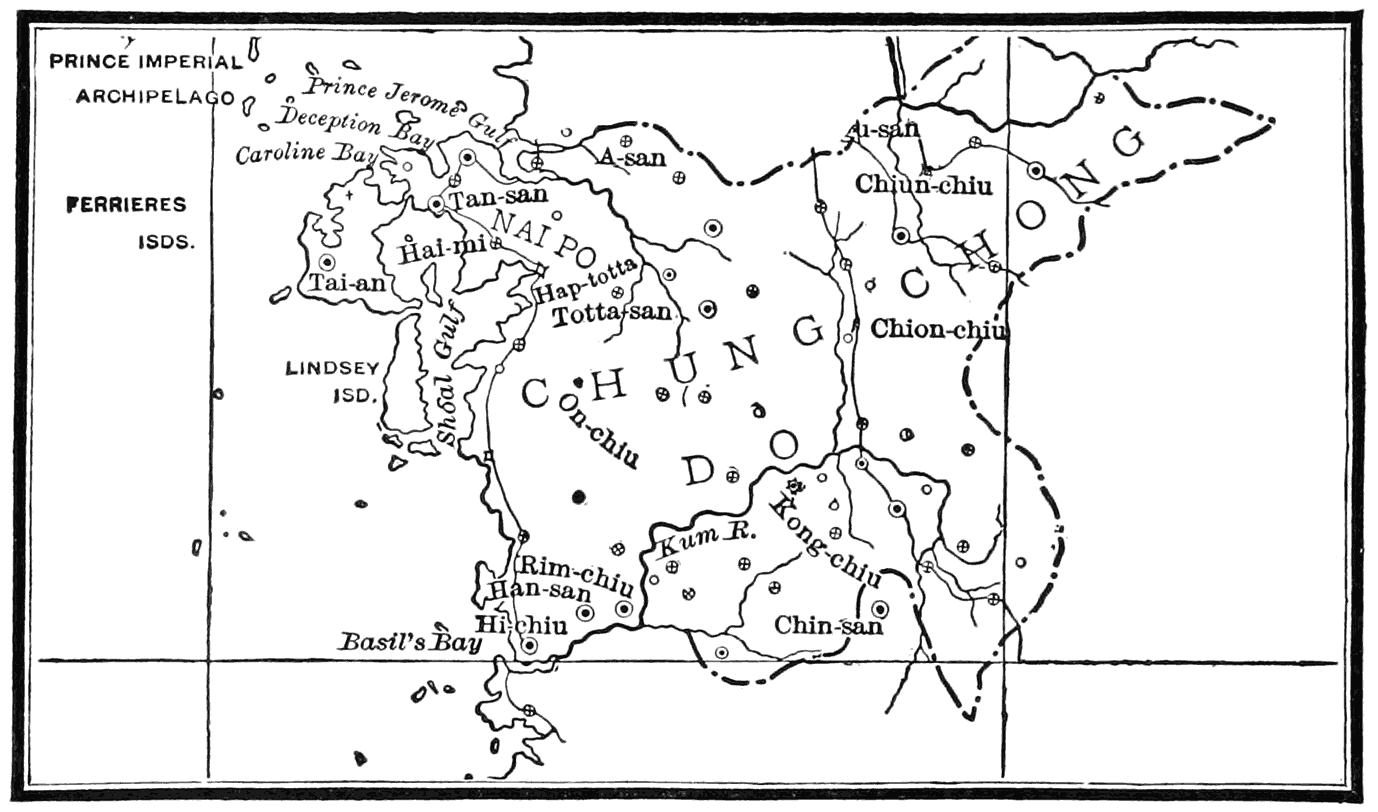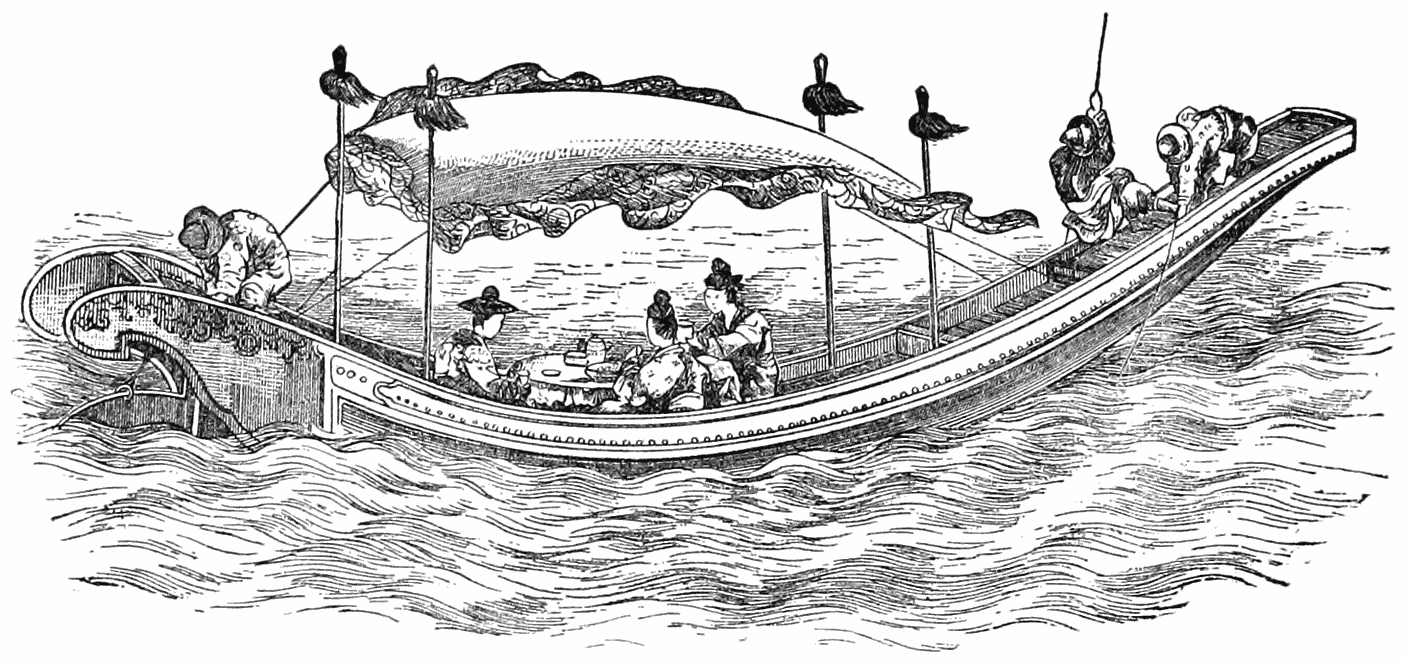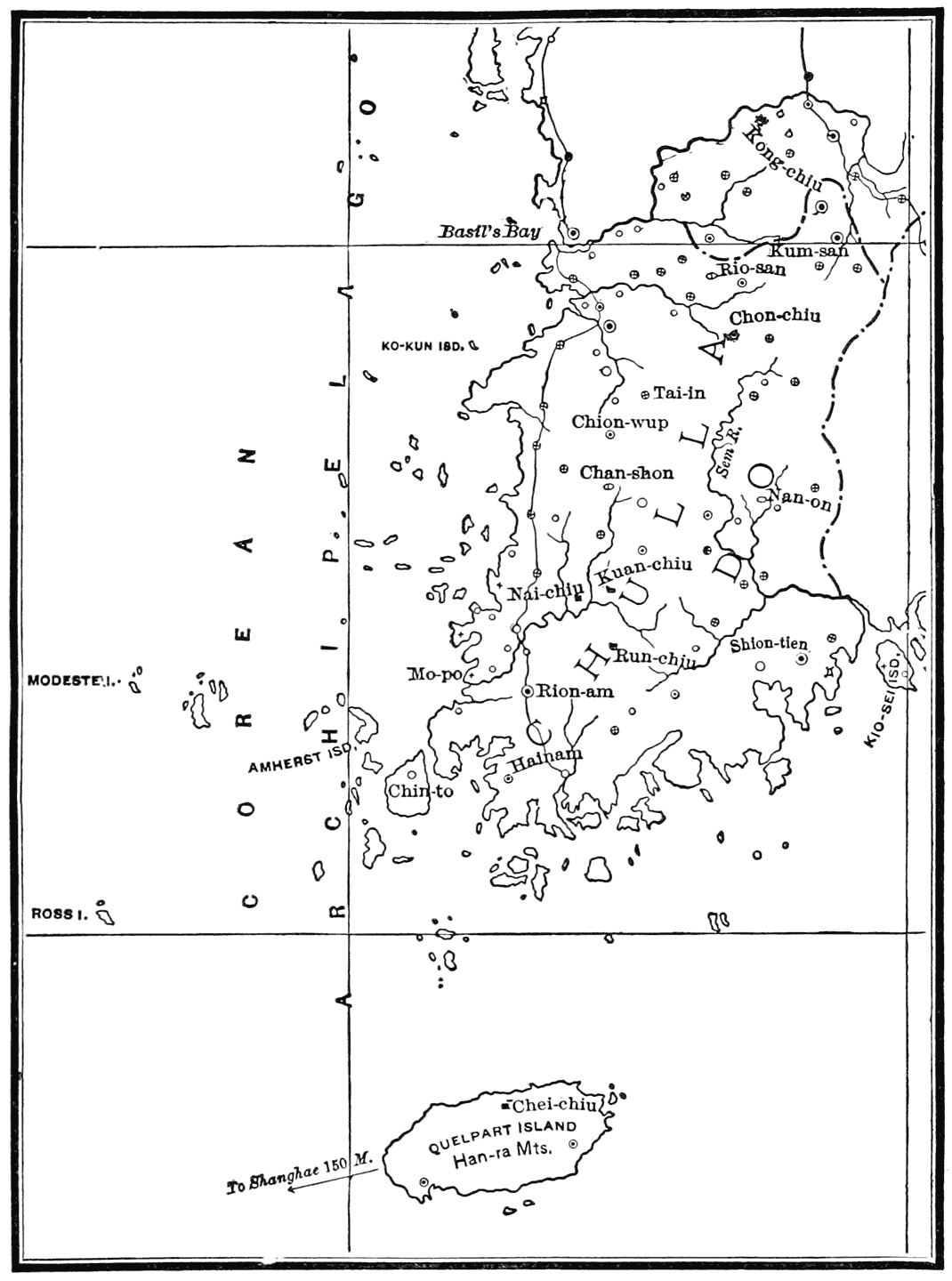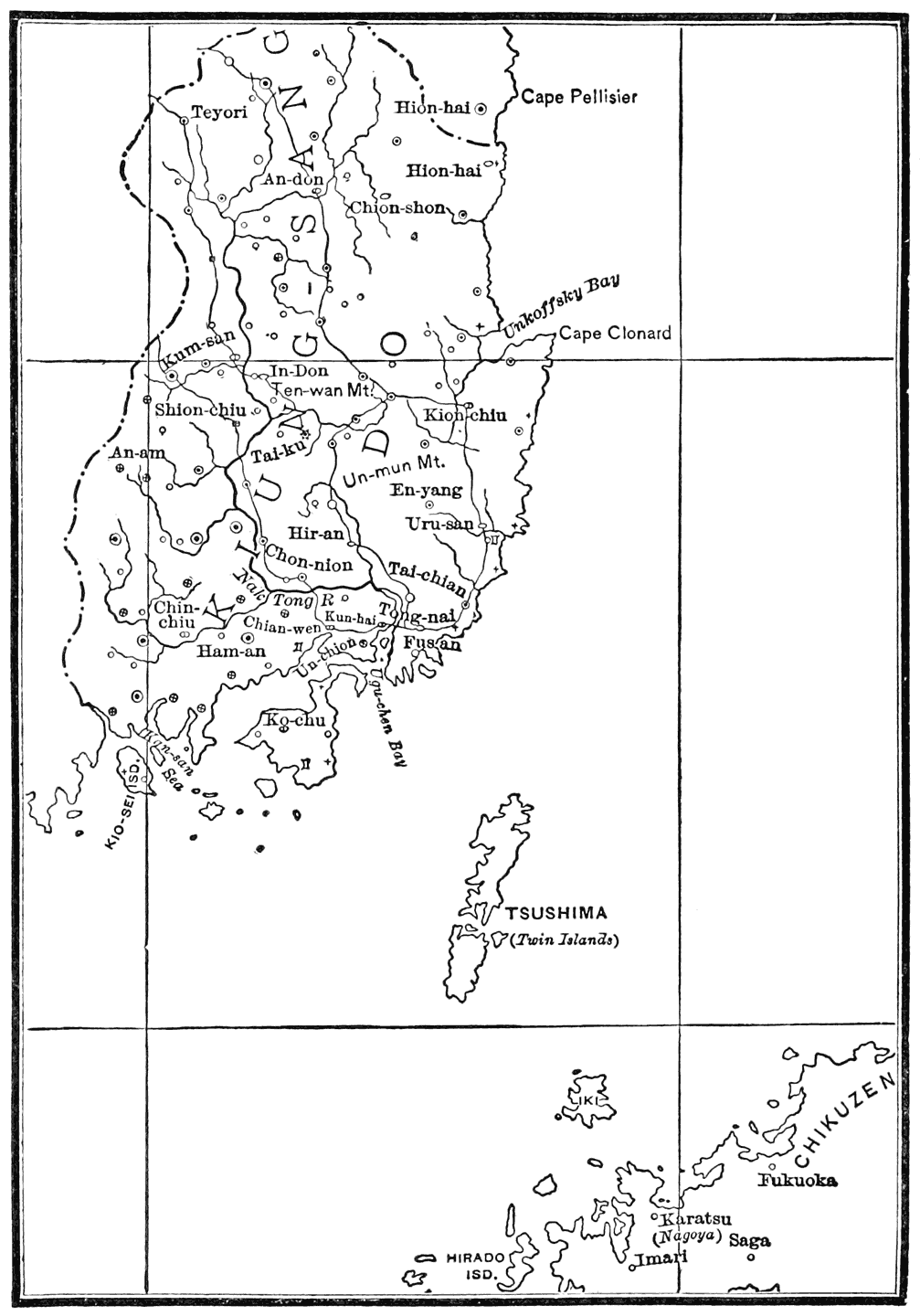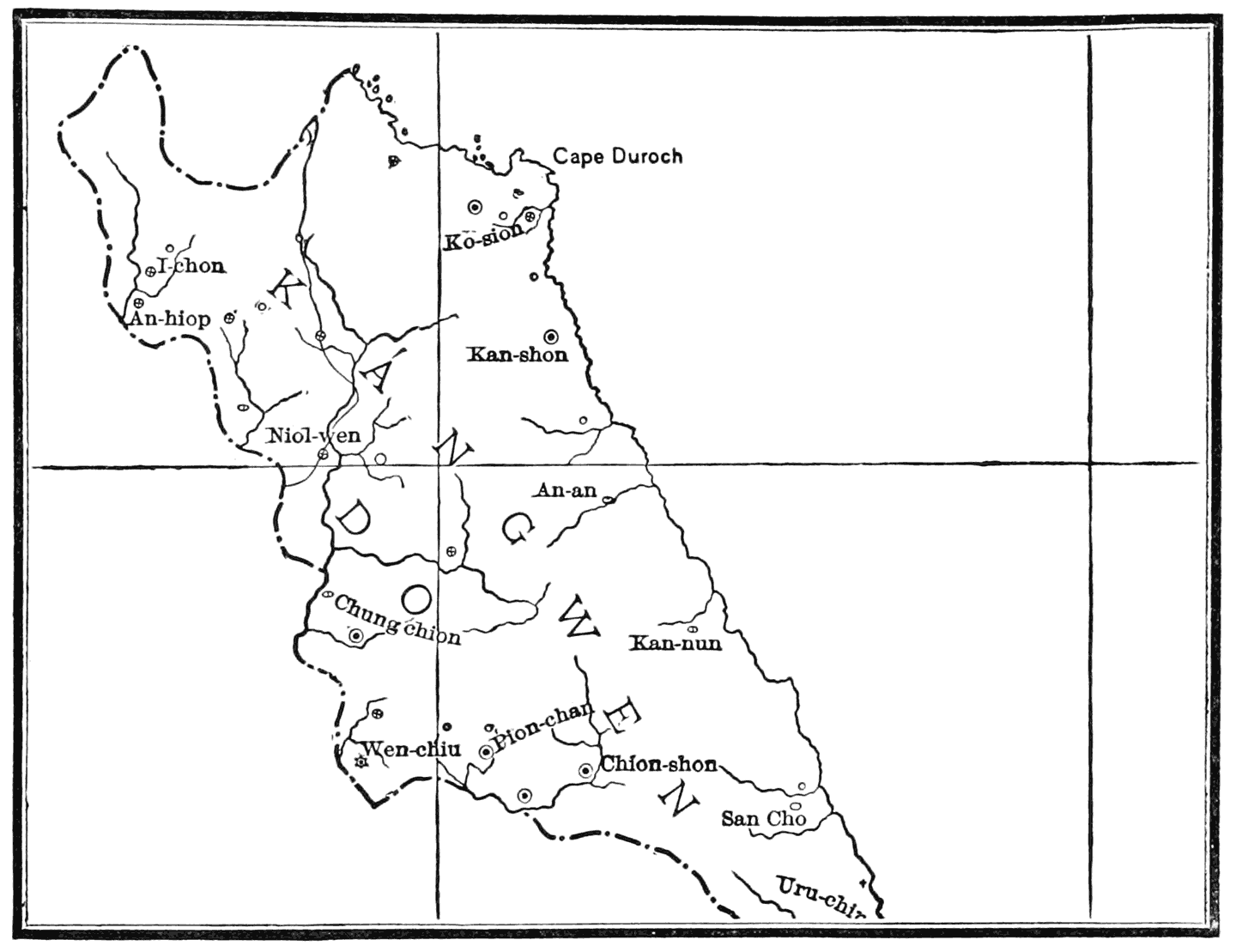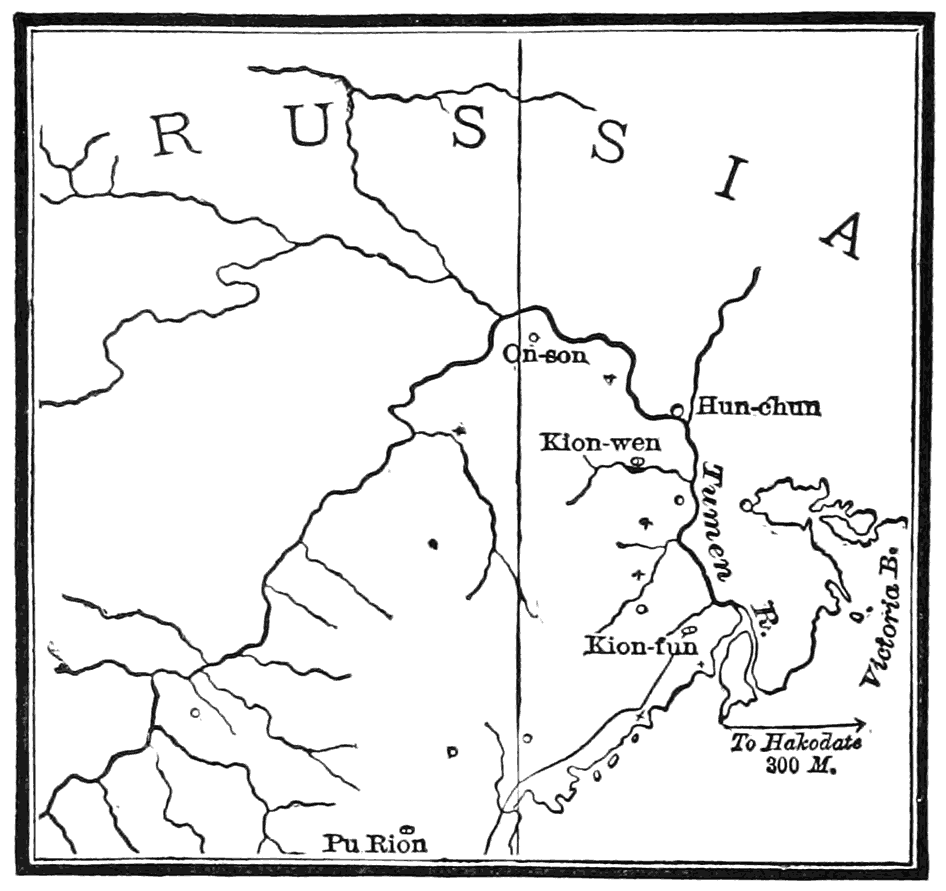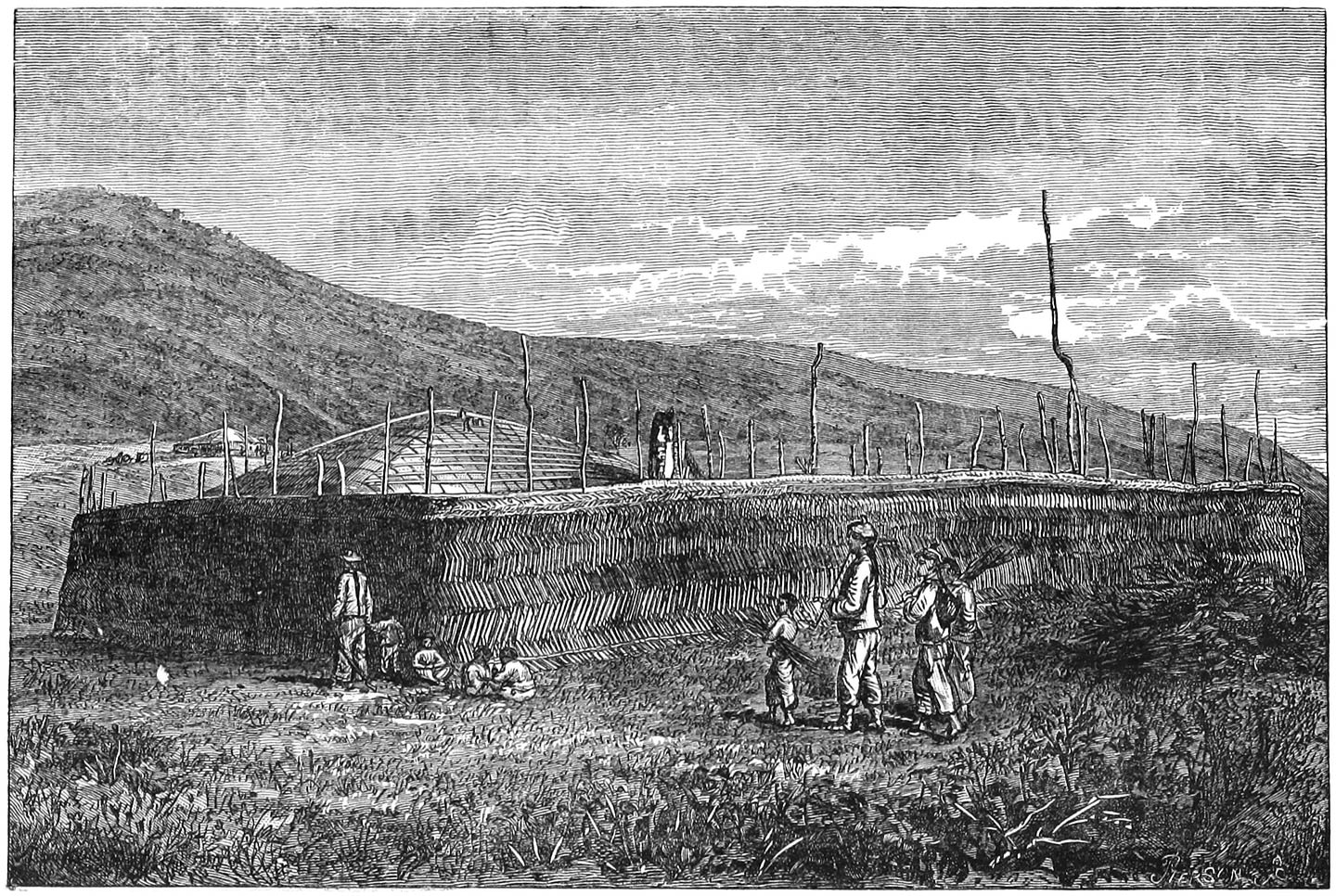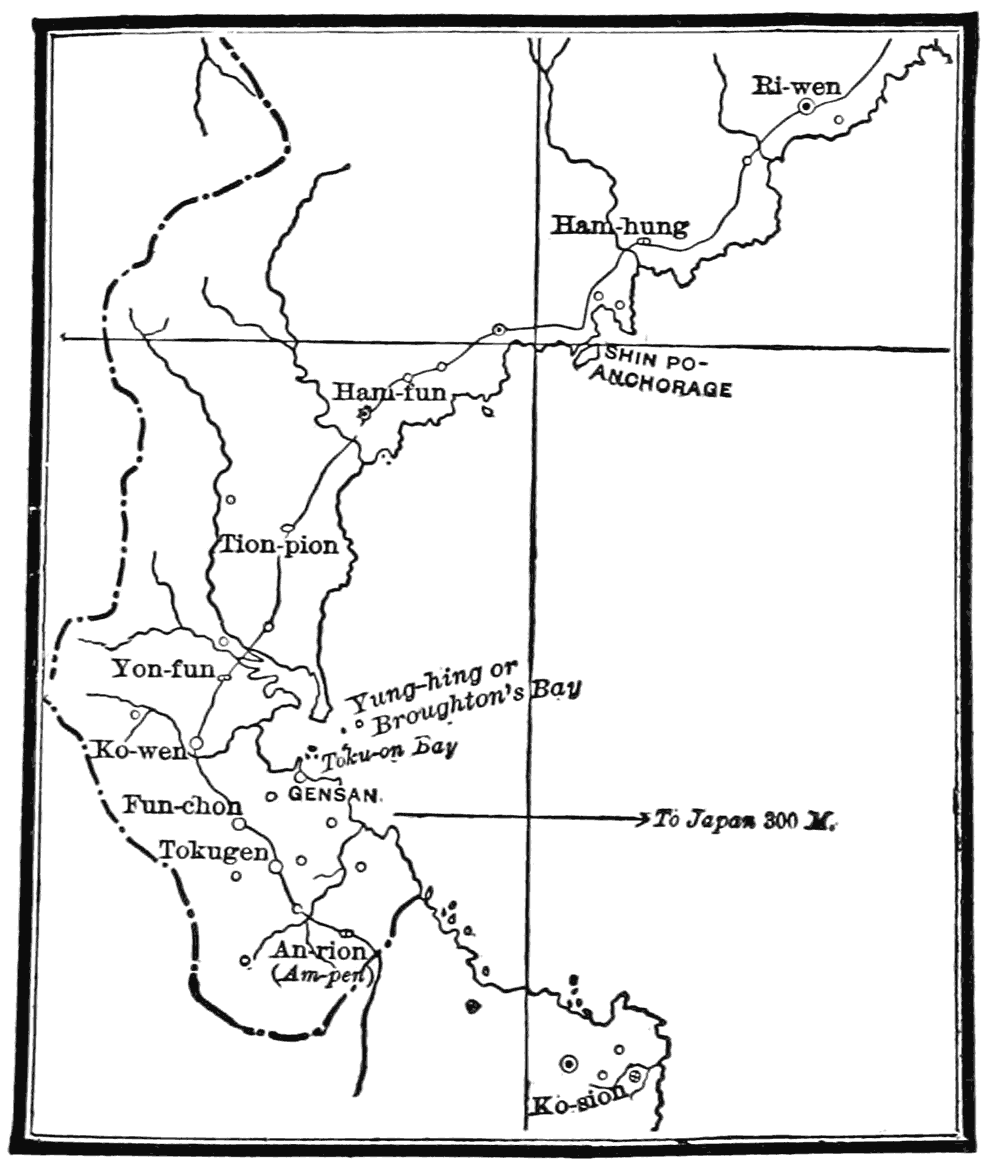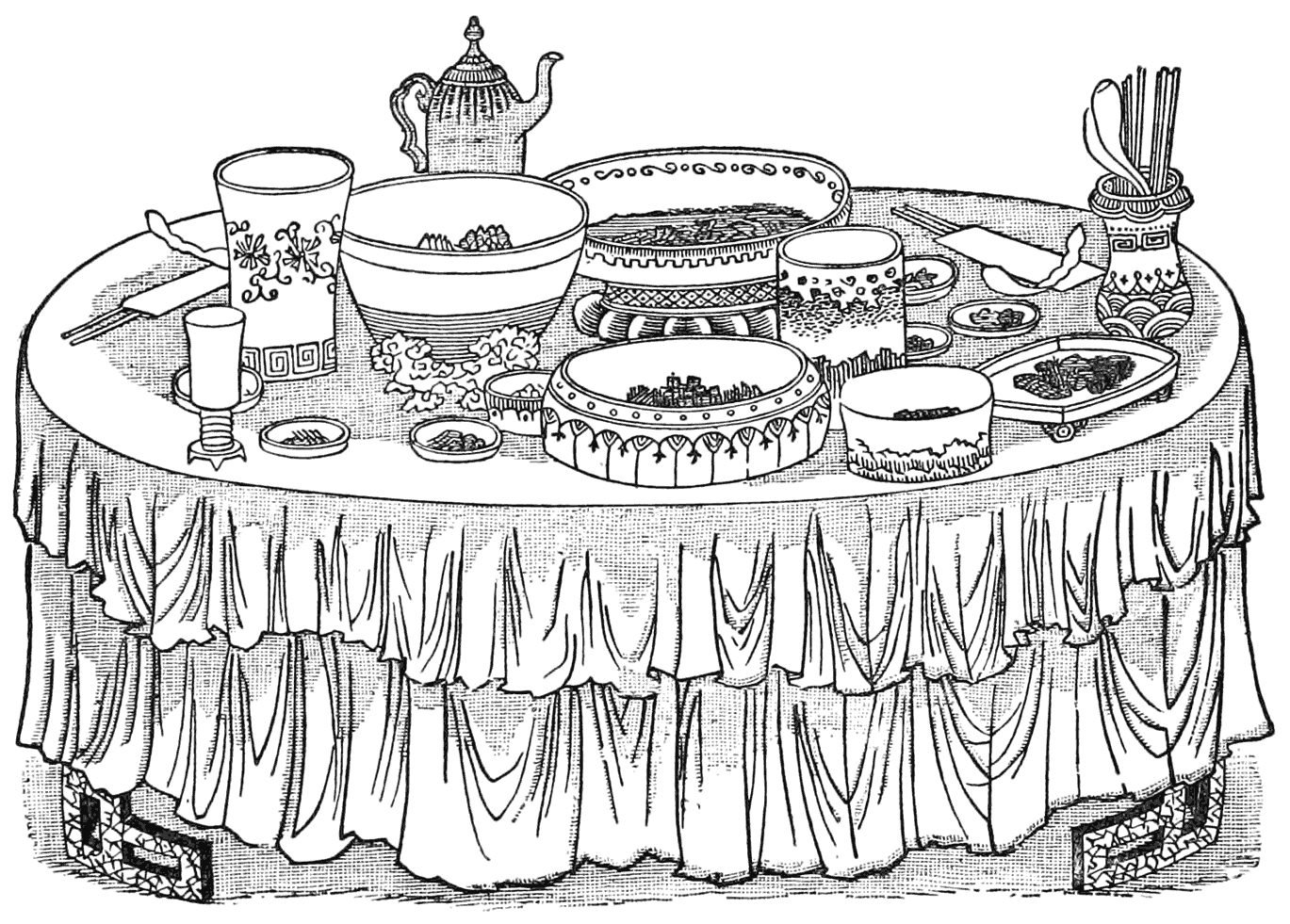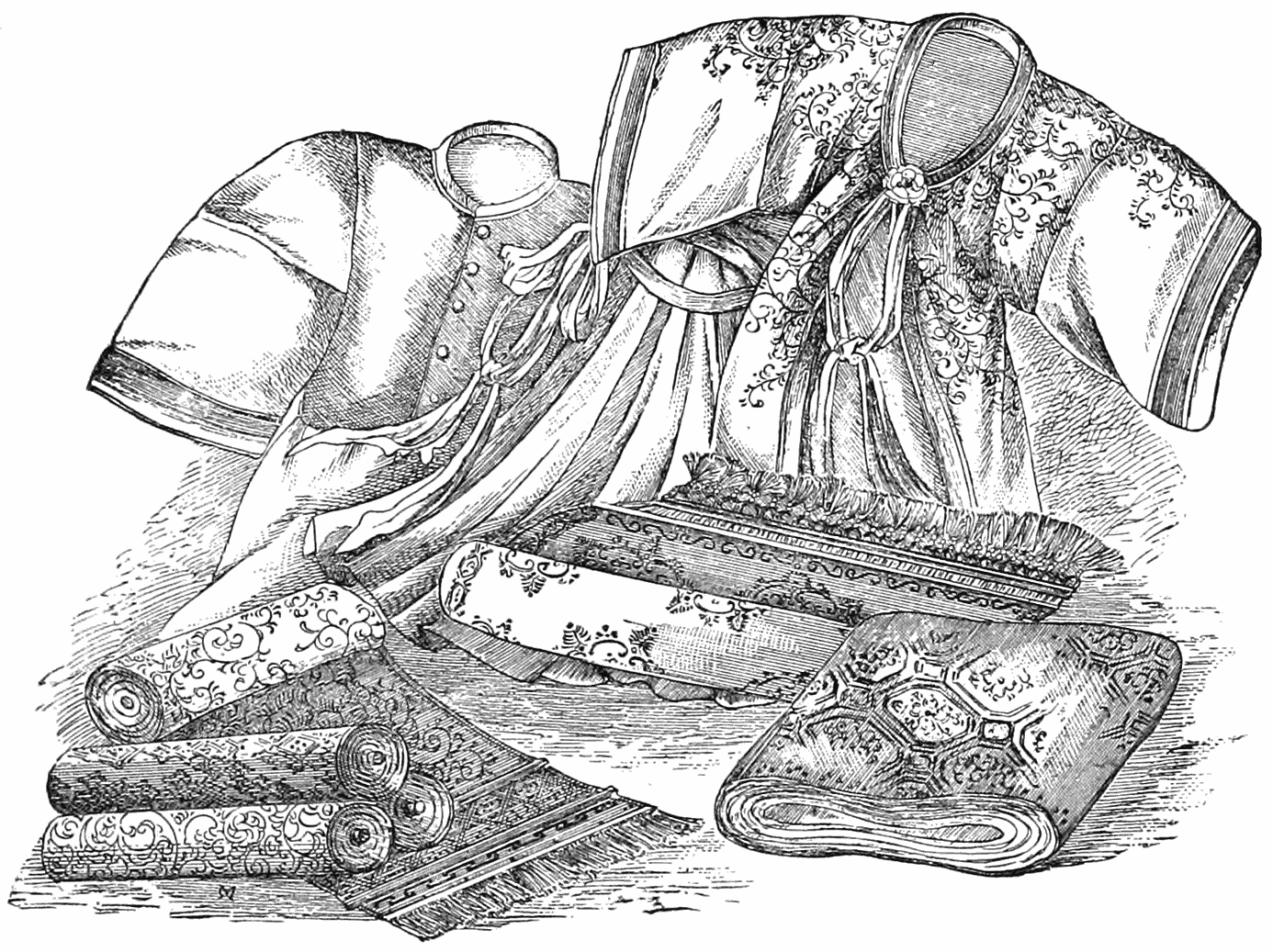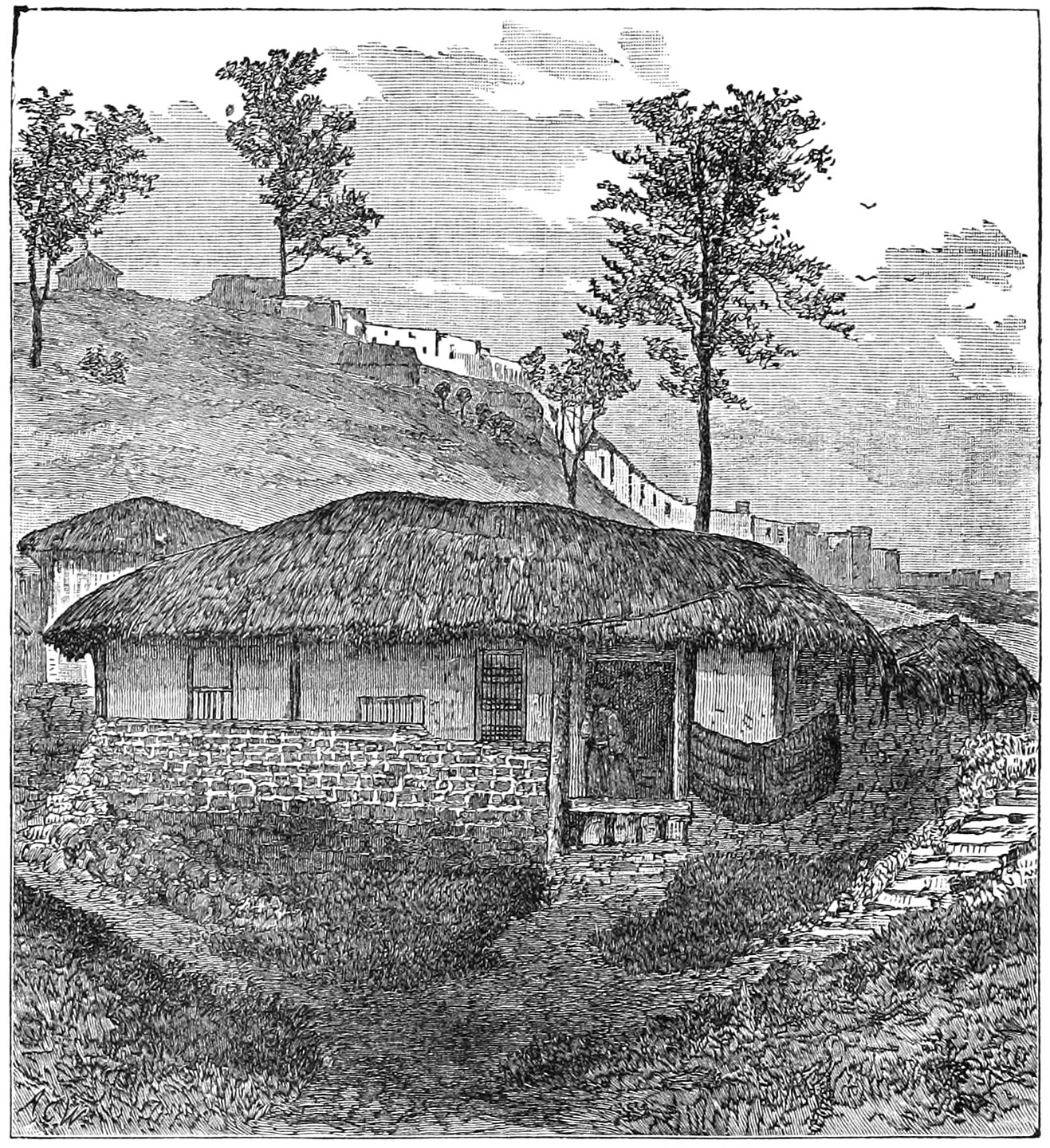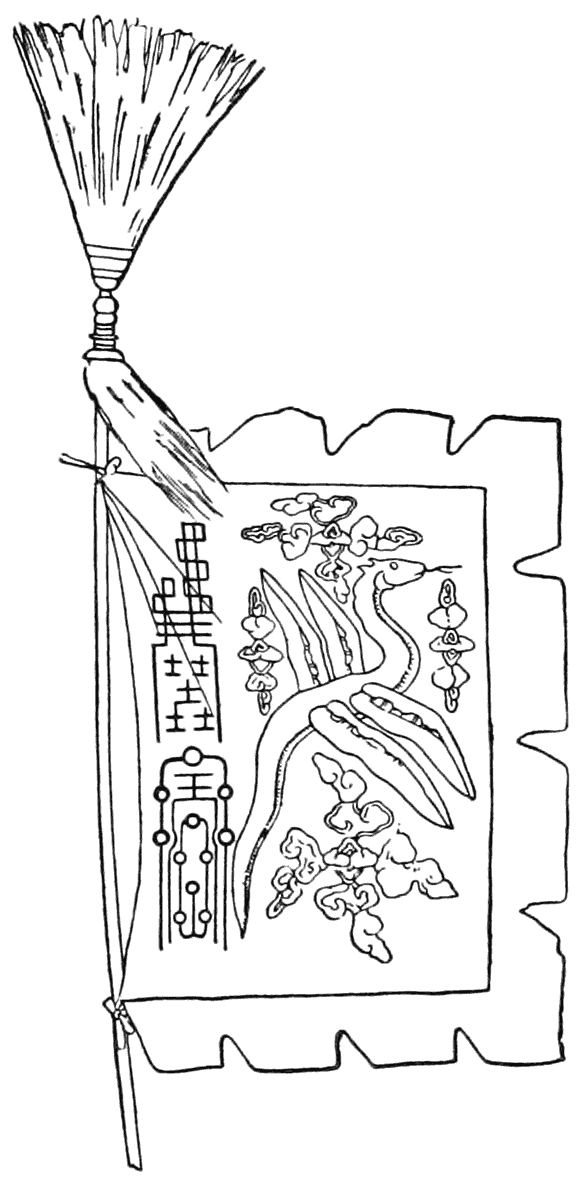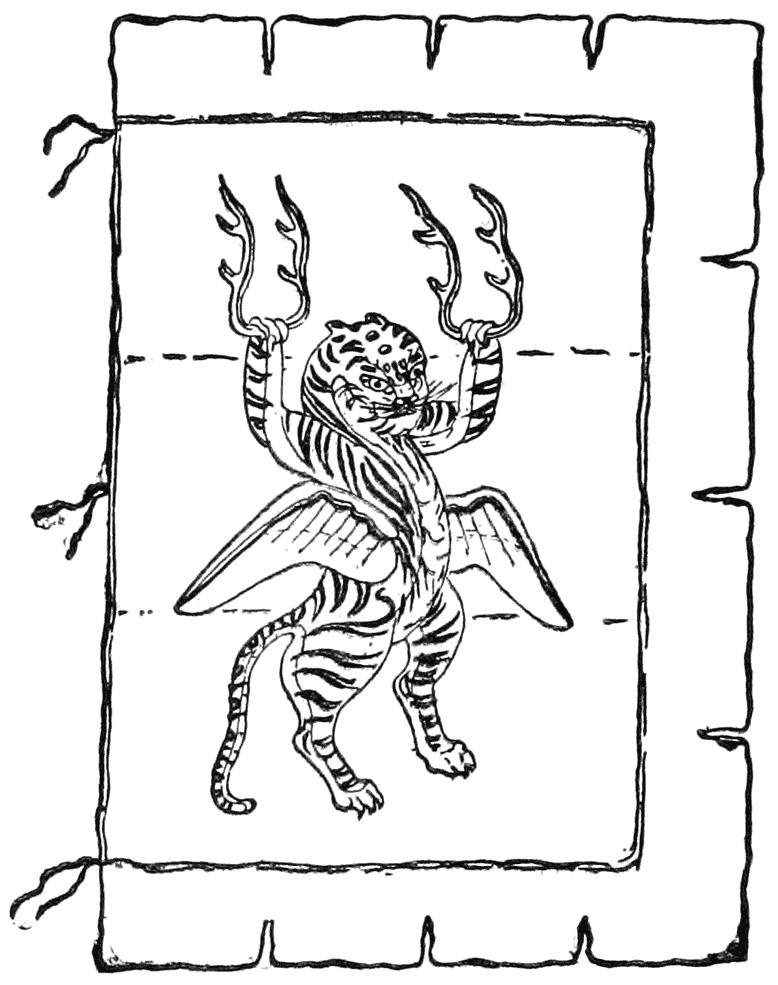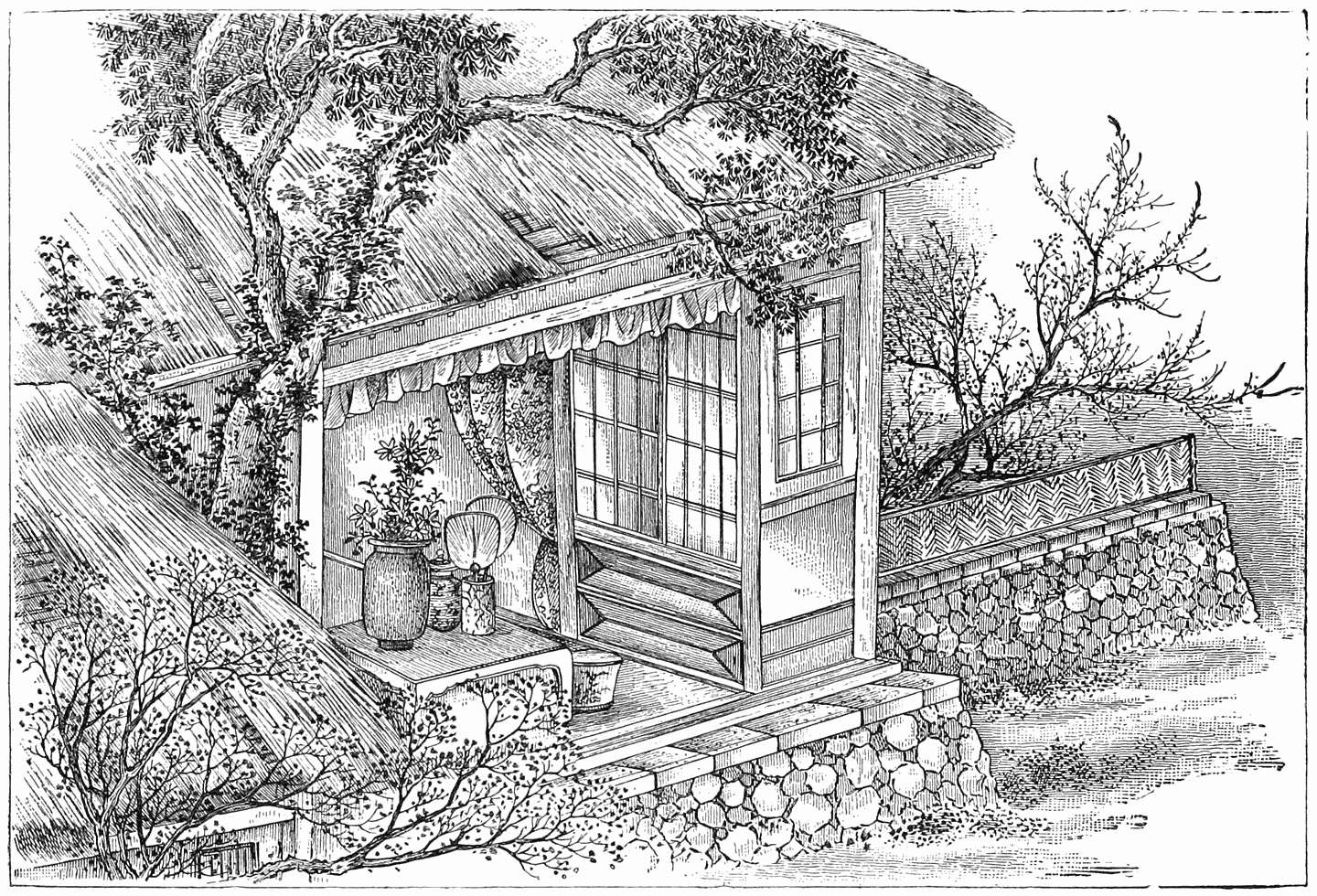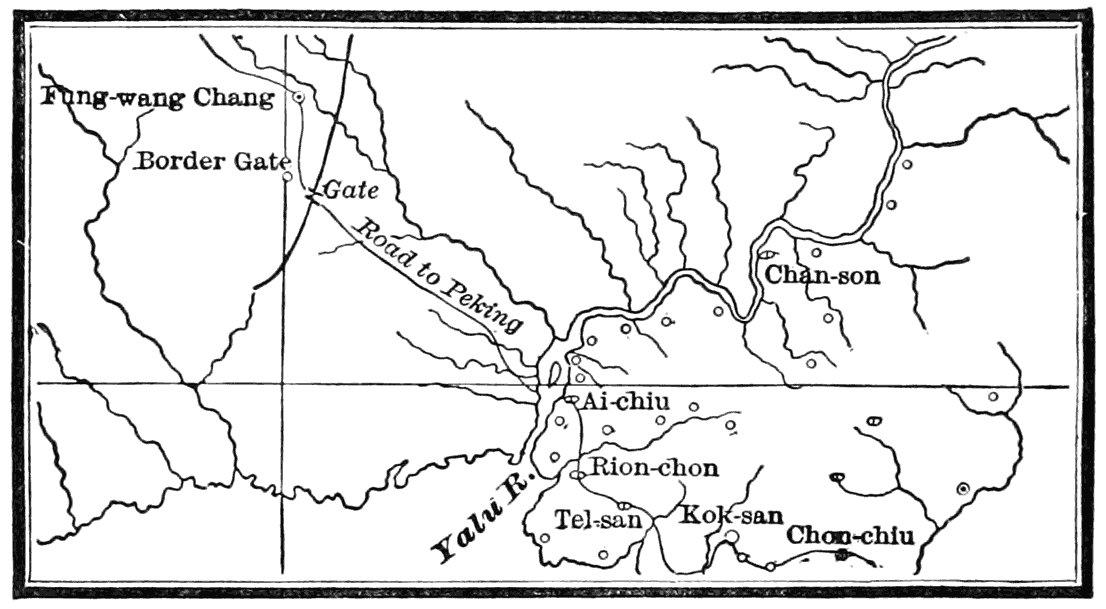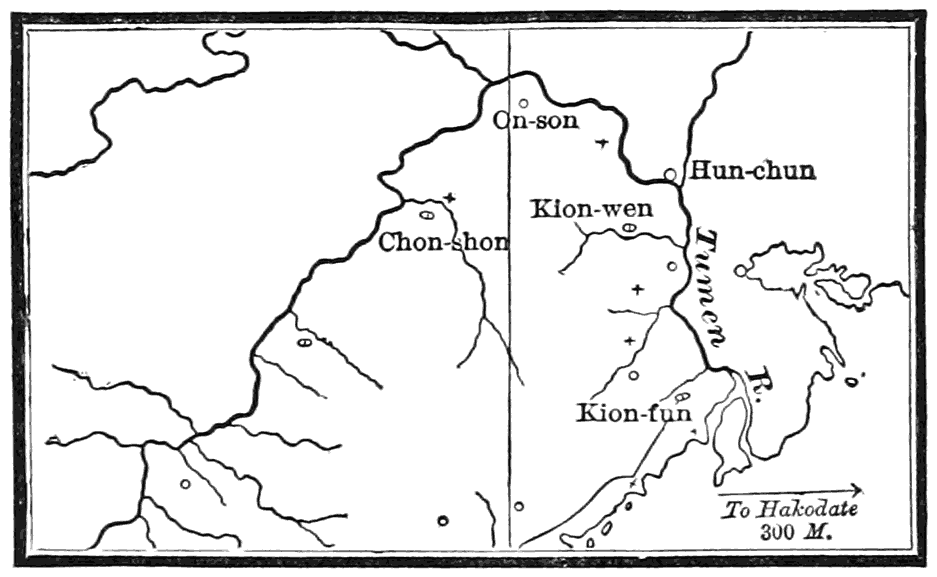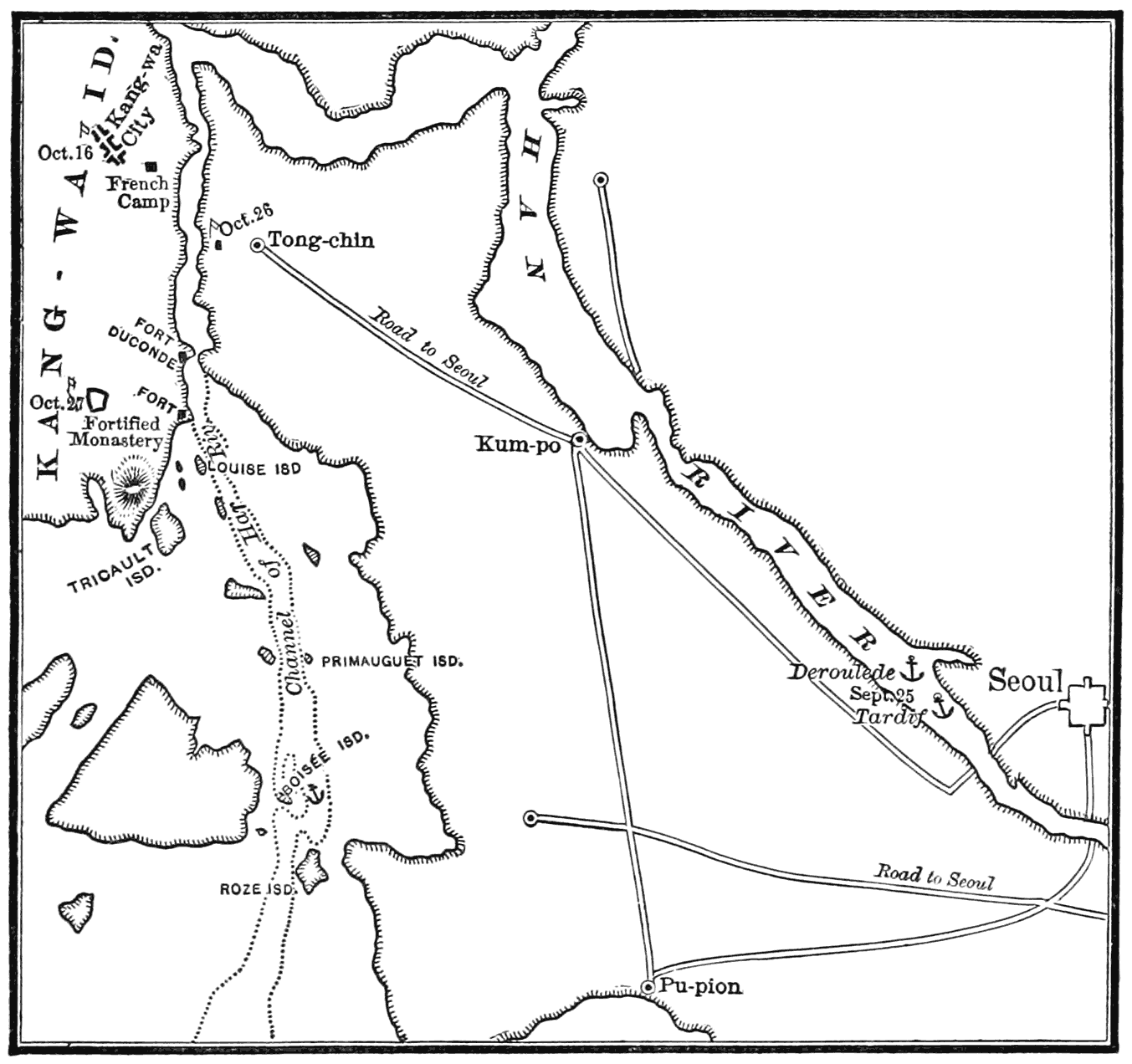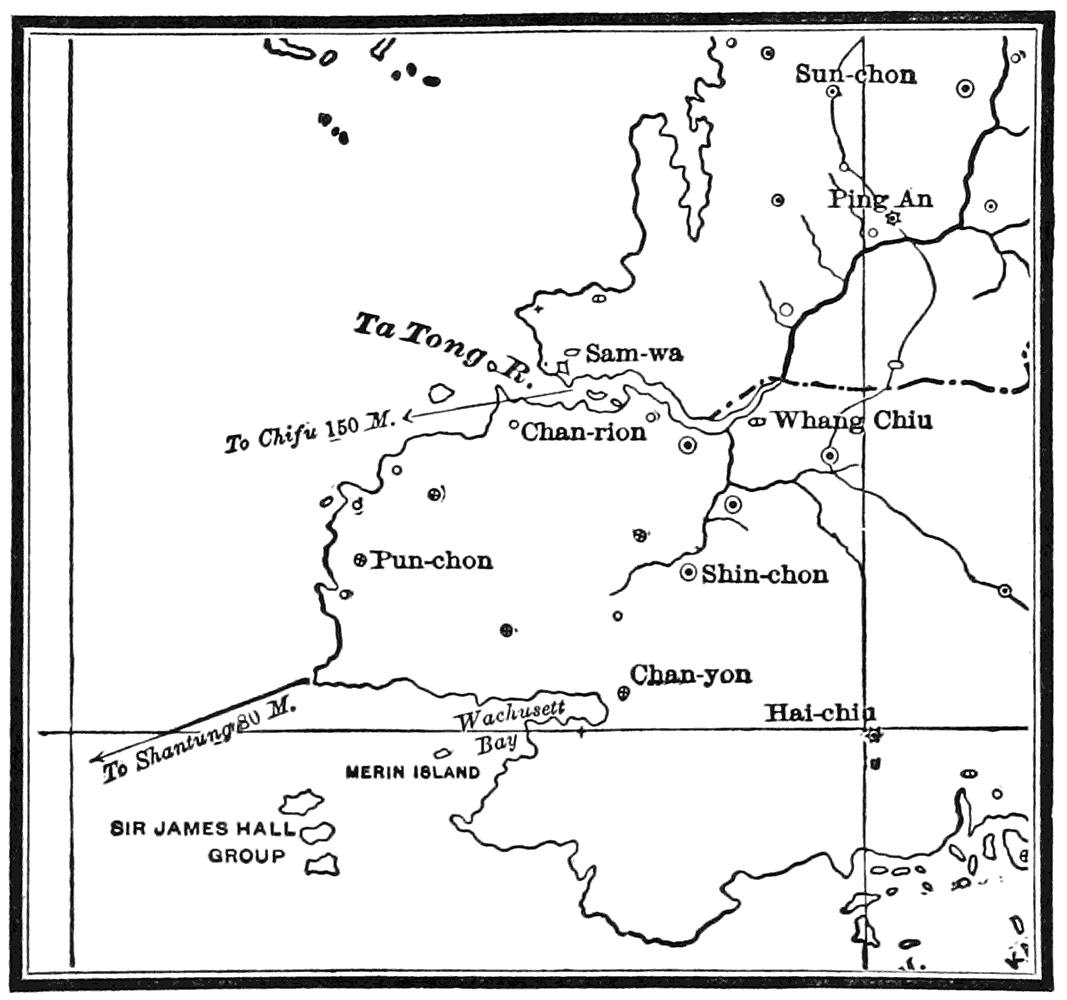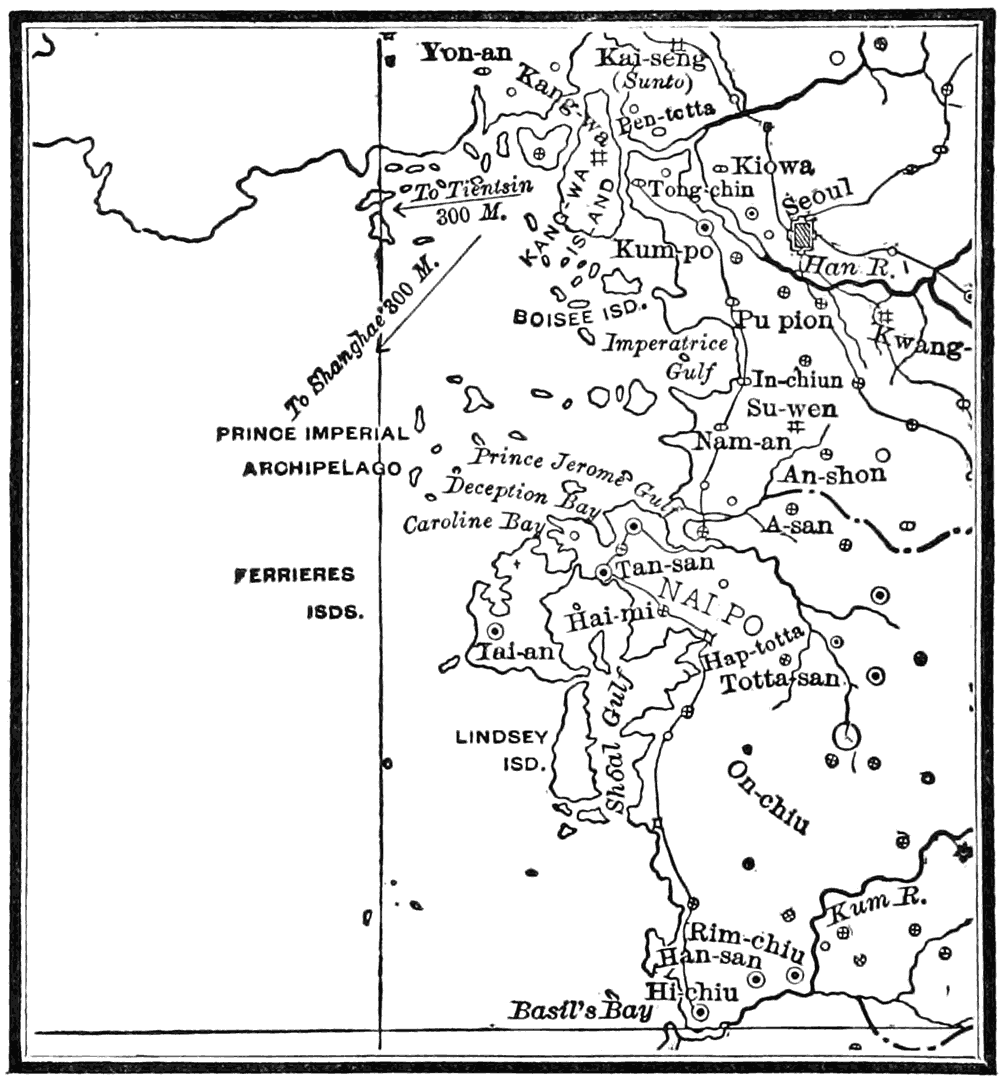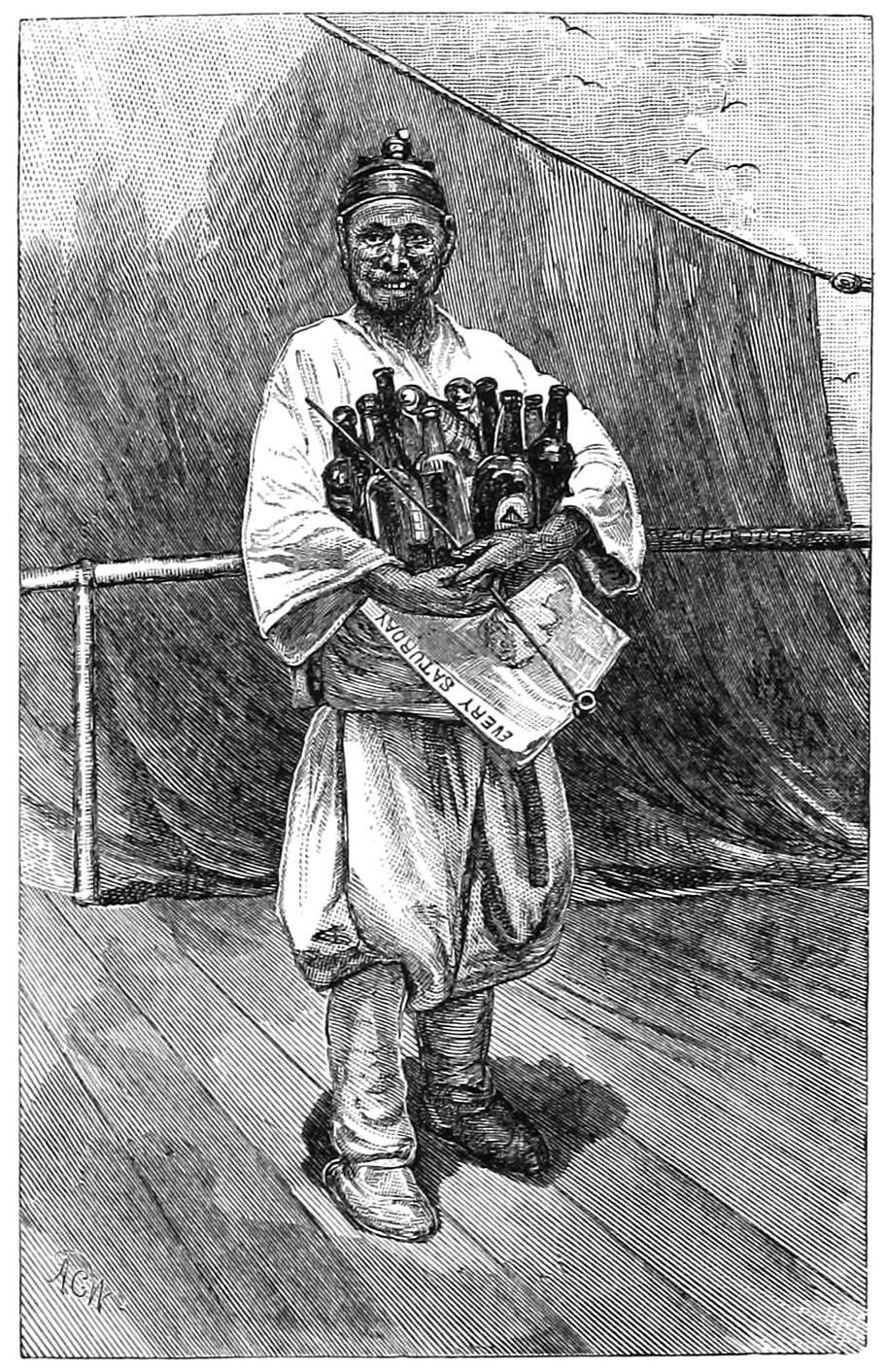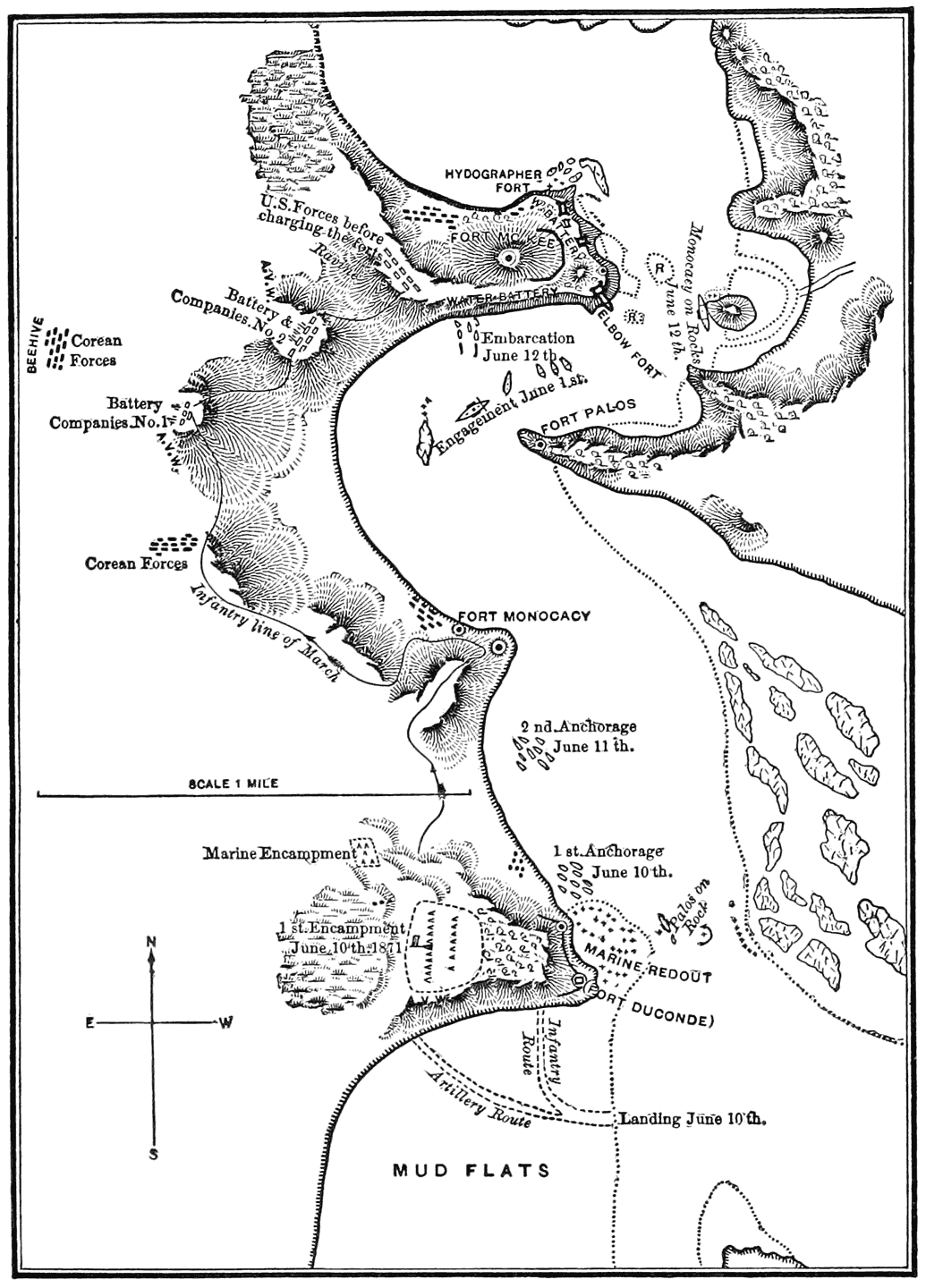
Works by Wm. Elliot Griffis
- THE MIKADO’S EMPIRE
- JAPANESE FAIRY WORLD
- COREA, THE HERMIT NATION
- MATTHEW CALBRAITH PERRY
- THE LILY AMONG THORNS
- HONDA, THE SAMURAI
- SIR WILLIAM JOHNSON
- JAPAN: IN HISTORY, FOLK-LORE, AND ART
- BRAVE LITTLE HOLLAND
- THE RELIGIONS OF JAPAN
- TOWNSEND HARRIS

A CITY IN COREA.

II.—POLITICAL AND SOCIAL COREA
III.—MODERN AND RECENT HISTORY
NEW YORK
CHARLES SCRIBNER’S SONS
1911
Copyright, 1882, 1888, 1897, 1904, 1907, 1911
By CHARLES SCRIBNER’S SONS
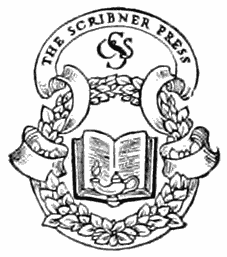
TO
ALL COREAN PATRIOTS:
WHO SEEK
BY THE AID OF SCIENCE, TRUTH, AND PURE RELIGION,
TO ENLIGHTEN
THEMSELVES AND THEIR FELLOW-COUNTRYMEN,
TO RID
THEIR LAND OF SUPERSTITION, BIGOTRY, DESPOTISM, AND
PRIESTCRAFT—BOTH NATIVE AND FOREIGN—
AND TO PRESERVE
THE INTEGRITY, INDEPENDENCE, AND HONOR, OF THEIR COUNTRY;
THIS UNWORTHY SKETCH
OF
THEIR PAST HISTORY AND PRESENT CONDITION
IS DEDICATED.
[v]
PREFACE TO THE NINTH EDITION.
The year 1910 saw the Land of the Plum Blossom and the Islands of the Cherry Blooms united. In this ninth edition of a work which for nearly thirty years has been a useful hand-book of information—having, by their own unsought confession, inspired not a few men and women to become devoted friends and teachers of the Corean people—I have made some corrections and added a final chapter, “Chō-sen: A Province of Japan.” Besides outlining in brief the striking events from 1907 to 1911, I have analyzed the causes of the extinction of Corean sovereignty, aiming in this to be a disinterested interpreter rather than a mere annalist.
Although the sovereignty of Corea, first recognized and made known to the world by the Japanese in their treaty of 1876, has been, through the logic of events, destroyed, I doubt not that the hopes of twelve millions of people will be increasingly fulfilled under the new arrangement. Not in haste, but only after long compulsion, did the statesmen of Japan assume a responsibility that may test to the full their abilities and those of their successors. The severe criticisms, in Japan itself, of the policy of the Tokio government bear witness to the sensitiveness of the national conscience in regard to the treatment of their colonies. In this respect, as in so many other points of public ethics, the Japanese are ranging themselves abreast with the leading nations that are making a world-conscience.
In sending forth what may be the final edition of a work, with the title of which time has had its revenges, while the contents are still of worth, the author thanks heartily all who, from 1876, when the work was planned, until the present time, have assisted in making this book valuable to humanity.
W. E. G.
Ithaca, N. Y., June 27, 1911. [vii]
PREFACE TO THE EIGHTH EDITION.
When in October, 1882, the publishers of “Corea the Hermit Nation” presented this work to the public of English-speaking nations, they wrote:
“Corea stands in much the same relation to the traveller that the region of the pole does to the explorer, and menaces with the same penalty the too inquisitive tourist who ventures to penetrate its inhospitable borders.”
For twenty-four years, this book, besides enjoying popular favor, has been made good use of by writers and students, in Europe and America, and has served even in Corea itself as the first book of general information to be read by missionaries and other new comers. In this eighth edition, I have added to the original text, ending with Chapter XLVIII (September, 1882), five fresh chapters: on The Economic Condition of Corea; International Politics: Chinese and Japanese; The War of 1894: Corea an Empire; Japan and Russia in Conflict; and Corea a Japanese Protectorate, bringing the history down to the late autumn of 1906.
Within the brief period of time treated in these new chapters, the centre of the world’s politics has shifted from the Atlantic and the Mediterranean to the waters surrounding Corea, the strange anomaly of dual sovereignty over the peninsular state has been eliminated, and the military reputation of China ruined, and that of Russia compromised. The rise of Japan, within half a century of immediate contact with the West, to the position of a modern state, able first to humiliate China and then to grapple successfully with Russia, has vitally affected Corea, on behalf of whose independence Japan a second time went to war with a Power vastly greater in natural resources than herself. In this period [viii]also, the United States of America has become one of the great Powers interested in the politics of Asia, and with which the would-be conquerors of Asiatic peoples must reckon.
The present or eighth edition shows in both text and map, not only the swift, logical results both of Japan’s military and naval successes in Manchuria and on the sea of Japan and of her signal diplomatic victory at Portsmouth, but more. It makes clear the reasons why Corea, as to her foreign relations, has lost her sovereignty.
The penalty laid upon the leaders of the peninsular kingdom for making intrigue instead of education their work, and class interests instead of national welfare their aim, is also shown to be pronounced—less by the writer than by the events themselves—in the final failure of intriguing Yang-banism, in May, 1906. The Japanese, in the administration of Corea, are like the other protecting nations, British, American, French, German, now on a moral trial before the world.
In again sending forth a work that has been so heartily welcomed, I reiterate gladly my great obligations to the scholars, native and foreign, who have so generously aided me by their conversation, correspondence, criticism, and publications, and the members of the Korean Branch of the Royal Asiatic Society, who have honored me with membership in their honorable body. My special obligations are due to our late American Minister, H. N. Allen, for printed documents and illustrative matter; to Professor Homer B. Hulbert, Editor of The Korea Review, from the pages of which I have drawn liberally, and to the Editor of The Japan Mail, the columns of which are rich in correspondence from Corea. I would call attention also to the additions made upon the map at the end of the volume.
I beg again the indulgence of my readers, especially of those who by long residence upon the soil, while so thoroughly able to criticize, have been so profuse in their expression of appreciation. From both sides of the Atlantic and Pacific have come these gratifying tokens, and to them as well as to my publishers, I make glad acknowledgments in sending forth this eighth edition.
W. E. G.
Ithaca, N. Y., December 12, 1906. [ix]
PREFACE TO THE FIRST EDITION.
In the year 1871, while living at Fukui, in the province of Echizen, Japan, I spent a few days at Tsuruga and Mikuni, by the sea which separates Japan and Corea. Like “the Saxon shore” of early Britain, the coast of Echizen had been in primeval times the landing-place of rovers, immigrants, and adventurers from the continental shore opposite. Here, at Tsuruga, Corean envoys had landed on their way to the mikado’s court. In the temple near by were shrines dedicated to the Corean Prince of Mimana, and to Jingu Kōgō, Ojin, and Takénouchi, whose names in Japanese traditions are associated with “The Treasure-land of the West.” Across the bay hung a sweet-toned bell, said to have been cast in Corea in A.D. 647; in which tradition—untested by chemistry—declared there was much gold. Among the hills not far away, nestled the little village of Awotabi (Green Nook), settled centuries ago by paper-makers, and visited a millenium ago by tribute-bearers, from the neighboring peninsula; and famous for producing the crinkled paper on which the diplomatic correspondence between the two nations was written. Some of the first families in Echizen were proud of their descent from Chō-sen, while in the villages, where dwelt the Eta, or social outcasts, I beheld the descendants of Corean prisoners of war. Everywhere the finger of tradition pointed westward across the waters to the Asian mainland, and the whole region was eloquent of “kin beyond sea.” Birds and animals, fruits and falcons, vegetables and trees, farmers’ implements and the potter’s wheel, names in geography and things [x]in the arts, and doctrines and systems in religion were in some way connected with Corea.
The thought often came to me as I walked within the moss-grown feudal castle walls—old in story, but then newly given up to schools of Western science and languages—why should Corea be sealed and mysterious, when Japan, once a hermit, had opened her doors and come out into the world’s market-place? When would Corea’s awakening come? As one diamond cuts another, why should not Chō-ka (Japan) open Chō-sen (Corea)?
Turning with delight and fascination to the study of Japanese history and antiquities, I found much that reflected light upon the neighbor country. On my return home, I continued to search for materials for the story of the last of the hermit nations. No master of research in China or Japan having attempted the task, from what Locke calls “the roundabout view,” I have essayed it, with no claim to originality or profound research, for the benefit of the general reader, to whom Corea “suggests,” as an American lady said, “no more than a sea-shell.” Many ask “What’s in Corea?” and “Is Corea of any importance in the history of the world?”
My purpose in this work is to give an outline of the history of the Land of Morning Calm—as the natives call their country—from before the Christian era to the present year. As “an honest tale speeds best, being plainly told,” I have made no attempt to embellish the narrative, though I have sought information from sources from within and without Corea, in maps and charts, coins and pottery, the language and art, notes and narratives of eye-witnesses, pencil-sketches, paintings and photographs, the standard histories of Japan and China, the testimony of sailor and diplomatist, missionary and castaway, and the digested knowledge of critical scholars. I have attempted nothing more than a historical outline of the nation and a glimpse at the political and social life of the people. For lack of space, the original manuscript of “Recent and Modern History,” part III., has been greatly abridged, and many topics of interest have been left untouched.
The bulk of the text was written between the years 1877 and [xi]1880; since which time the literature of the subject has been enriched by Ross’s “Corea” and “Corean Primer,” besides the Grammar and Dictionary of the Corean language made by the French missionaries. With these linguistic helps I have been able to get access to the language, and thus clear up doubtful points and obtain much needed data. I have borrowed largely from Dallet’s “Histoire d’Eglise de Corée,” especially in the chapters devoted to Folk-lore, Social Life, and Christianity. In the Bibliography following the Preface is a list of works to which I have been more or less indebted.
Many friends have assisted me with correspondence, advice, or help in translation, among whom I must first thank my former students, Haségawa, Hiraii, Haraguchi, Matsui, and Imadatté, and my newer Japanese friends, Ohgimi and Kimura, while others, alas! will never in this world see my record of acknowledgment—K. Yaye′ and Egi Takato—whose interest was manifested not only in discussion of mooted points, but by search among the book-shops in Kiōto and Tōkiō, which put much valuable standard matter in my hands. I also thank Mr. Charles Lanman, Secretary of the Legation of Japan in Washington, for four ferrotypes taken in Seoul in 1878 by members of the Japanese embassy; Mr. D. R. Clark, of the United States Transit of Venus Survey, for four photographs of the Corean villages in Russian Manchuria; Mr. R. Idéura, of Tōkiō, for a set of photographs of Kang-wa and vicinity, taken in 1876, and Mr. Ozawa Nankoku, for sketches of Corean articles in Japanese museums. To Lieutenant Wadhams, of the United States Navy, for the use of charts and maps made by himself while in Corea in 1871, and for photographs of flags and other trophies, now at Annapolis, captured in the Han forts; to Fleet-Surgeon H. O. Mayo, and other officers of the United States Navy, for valuable information, I hereby express my grateful appreciation of kindness shown. I would that Admiral John Rodgers, Commodore H. C. Blake, and Minister F. F. Low were living to receive my thanks for their courtesies personally shown me, even though, in attempting to write history, I have made criticisms also. To Lieutenant N. Y. Yanagi, of the Hyrographic Bureau, of the Japanese Navy, for a [xii]set of charts of the coast of Corea; to Mr. Metcalfe, of Milwaukee, for photographs of Coreans; to Miss Marshall, of New York, for making colored copies of the battle-flags captured by our naval battalion in 1871, and for the many favors of correspondents—in St. Petersburg, Mr. Hoffman Atkinson; in Peking, Jugoi Arinori Mori; in Tōkiō, Dr. D. B. McCartee, Hon. David Murray, Rev. J. L. Amerman, and others whose names I need not mention. To Gen. George W. McCullum, Vice-President, and to Mr. Leopold Lindau, Librarian, of the American Geographical Society, I return my warmest thanks; as well as to my dear wife and helpmeet, for her aid in copying, proof-reading, suggestions, and criticism during the progress of the work.
In one respect, the presentation of such a subject by a compiler, while shorn of the fascinating element of personal experience, has an advantage even over the narrator who describes a country through which he has travelled. With the various reports of many witnesses, in many times and places, before him, he views the whole subject and reduces the many impressions of detail to unity, correcting one by the other. Travellers usually see but a portion of the country at one time. The compiler, if able even in part to control his authorities, and if anything more than a tyro in the art of literary appraisement, may be able to furnish a hand-book of information more valuable to the general reader.
In the use of my authorities I have given heed to Bacon’s advice—tasting some, chewing others, and swallowing few. In ancient history, original authorities have been sought, and for the story of modern life, only the reports of careful eye-witnesses have been set down as facts; while opinions and judgments of alien occidentals concerning Corean social life are rarely borrowed without due flavoring of critical salt.
Corean and Japanese life, customs, beliefs, and history are often reflections one of the other. Much of what is reported from Corea, which the eye-witnesses themselves do not appear to understand, is perfectly clear to one familiar with Japanese life and history. China, Corea, and Japan are as links in the same chain of civilization. Corea, like Cyprus between Egypt and Greece, will yet [xiii]supply many missing details to the comparative student of language, art, science, the development of civilization, and the distribution of life on the globe.
Some future writer, with more ability and space at command than the undersigned, may discuss the question as to how far the opening of Corea to the commerce of the world has been the result of internal forces; the scholar, by his original research, may prepare the materials for a worthy history of Corea during the two or three thousand years of her history; the geologist or miner may determine the question as to how far the metallic wealth of Corea will affect the monetary equilibrium of the world. The missionary has yet to prove the full power of Christianity upon the people—and before Corean paganism, any form of the religion of Jesus, Roman, Greek or Reformed, should be welcomed; while to the linguist, the man of science, and the political economist, the new country opened by American diplomacy presents problems of profound interest.
W. E. G.
Schenectady, N. Y., October 2, 1882. [xv]
BIBLIOGRAPHY.
The following is a list of books and papers containing information about Corea. Those of primary value to which the compiler of this work is specially indebted are marked with an asterisk (*); those to which slight obligation, if any, is acknowledged with a double asterisk; and those which he has not consulted, with a dagger (†). See also under The Corean Language and Cartography, in the Appendix.
* History of the Eastern Barbarians. “Book cxv. contains a sketch of the tribes and nations occupying the northeastern seaboard of China, with the territory now known as Manchuria and Corea.” This extract from a History of the Later Han Dynasty (25–220 A.D.), by a Chinese scholar of the fifth century, has been translated into English by Mr. Alexander Wylie, and printed in the Revue de l’Extrême Orient, No. 1, 1882. Du Halde and De Mailla, in French, and Ross, in English, have also given the substance of the Chinese writer’s work, which also furnishes the basis of Japanese accounts of Corean history previous to the fourth century.
† The Subjugation of Chaou-seen, by A. Wylie. (Atti del IV. Cong. int. degli Orient, ii., pp. 309–315, 1881.) This fragment is a translation of the 95th book of the History of the Former Han Dynasty of China.
* Empire de la Chine et la Tartarie Chinoise, par P. du Halde.
* The Kōjiki and Nihongi, written in Japan during the eighth century, throws much light on the early history of Corea.
* Wakan-San-sai Dzuyé. Article on Chō-sen in this great Japanese Encyclopædia.
† Tong-Kuk Tong-Kan (General View of the Eastern Kingdom), a native Corean history written in Chinese.
* Zenrin Koku Hoki (Precious Jewels from a Neighboring Country), by Shiuho. Japan, 1586.
* Corea, its History, Manners, and Customs, by John Ross. 1 vol., pp. 404. Illustrations and maps. Paisley, 1880.
* The Chinese Reader’s Manual, by W. Fred. Mayers. 1 vol., pp. 440. Shanghae, 1874. An invaluable epitome of Chinese history, biography, chronology, bibliography, and whatever is of interest to the student of Chinese literature.
* Kō-chō Rekidai Enkaku Zukai. Historical Periods and Changes of the Japanese Empire, with maps and notes, by Otsuki Tōyō. [xvi]
** San Koku Tsu-ran To-setsu. Mirror of the Three [Tributary] Kingdoms, Chō-sen, Riu kiu, and Yezo, by Rin Shihei, 1785. This work, with its maps, was translated into French by J. Klaproth, and published in Paris, 1832. 1 vol. 8vo, pp. 288, of which pp. 158 relate to Chō-sen. Digested also in Siebold’s Archiv.
** Archiv zur Beschreibung von Japan, by Franz von Siebold. This colossal work contains much matter in text and illustrations relating to Corea, and the digest of several Japanese books, in the part entitled Nachrichten über Korai, Japan’s Bezüge mit der Koraischen Halbinsel und mit Schina.
** Corea und dessen Einfluss auf die Bevölkerung Japans. Zeit. für Ethnologie, Zitzungbericht VIII. p. 78, 1876. P. Kempermann.
** O Dai Ichi Ran. This work, containing the annals of the emperors of Japan, is a bird’s-eye view of the principal events in Japanese history, written in the style of an almanac, which Titsingh copied down from translations made by Japanese who spoke Dutch. Klaproth revised and corrected Titsingh’s work, and published his own version in 1834. Paris and London, 8vo, pp. 460. This work contains many references to Corea and the relations of the two countries, transcribed from the older history.
** Tableaux Historiques de l’Asie, depuis la monarchie de Cyrus jusque nos jours, accompagnes de recherches historiques et ethnographiques, etc. Par J. Klaproth, Paris, 1826. Avec un atlas in folio. This manual of the political geography of Asia is very useful, but not too accurate.
† A Heap of Jewels in a Sea of Learning (Gei Kai Shu Jin; Jap. pron.). A chapter from this Chinese book treats of Corea.
† Chō-sen Hitsu Go-shin. A collection of conversations with the pen, with a Corean who could not speak Japanese. By Ishikawa Rokuroku Sanjin, Yedo.
* The Classical Poetry of the Japanese. By Basil Hall Chamberlain. London, 1880.
** An Outline History of Japanese Education, New York, 1876. This monograph, prepared for the Centennial Exposition at Philadelphia, reviews the educational influences of Corea upon Japan. The information given is, with other data, from Klaproth, utilized in Pickering’s Chronological History of Plants, by Charles Pickering, M.D., Boston, 1879.
* Japanese Chronological Tables. By William Bramsen, Tōkiō, 1880. An invaluable essay on Japanese chronology, which was, like the Corean, based on the Chinese system. We have used this work of the lamented scholar (who died a few months after it was published) in rendering dates expressed in terms of the Chinese into those of the Gregorian or modern system.
** History of the Mongols. 3 vols. pp. 1827. London, 1876. By Henry Howorth. This portly work is full of the fruits of research concerning the people led by Genghis Khan. It contains excellent maps of Asia, and of Mongolia, and Manchuria, illustrating the Mongol conquests.
† Chō-sen Ki-che. (Memorandum upon Corean Affairs.) The Chinese ambassador sent by the Ming emperor in 1450, gives in this little work an account of his journey, which throws light upon the political and geographical situation of Chō-sen and China at that time. Quoted by M. Scherzer, but not translated. [xvii]
* Nihon Guaishi. Military History of Japan, by Rai Sanyo. This is the Japanese standard history. It was published in 1827 in twenty-two volumes. It covers the period from the Taira and Minamoto families to that of the Tokugawa in the seventeenth century. The first part of this work was translated into English by Mr. Ernest Satow, and published in The Japan Mail at Yokohama, 1872–74. In the latter portion the invasion of Chō-sen, 1592–97, is outlined.
* Chō-sen Seito Shimatsŭki. A work in five volumes, giving an account of the embassies, treaties, documents relating to the invasion of 1592–97, with an outline of the war, geographical notes, with nine maps by Yamazaki Masanagi and Miura Katsuyoshi.
* Illustrated History of the Invasion of Chō-sen. Written by Tsuruminé Hikoichiro. Illustrations by Hashimoto Giokuron. 20 vols. Yedo, 1853. This popular work, besides an outline of Corean history from the beginning, condensed from local legends and Chinese writers, details the operations of war and diplomacy relating to Hidéyoshi’s invasion. It is copiously illustrated with first-class wood engravings. It has not been translated.
* Chō-sen Monogatari. A Diary and Narrative of the Japanese Military Operations in Chō-sen during the Campaign of 1594–97, by Okoji Hidémoto. Copied out and published in 1672, and again in 1849. This narrative of an eye-witness was written by the author at the time of the events described, and afterward copied by his own son and deposited in the temple at which his ancestors worshipped. This vivid and spirited story of the second invasion of Chō-sen by Hidéyoshi has been translated into German by Dr. A. Pfizmaier, under the title Der Feldzug der Japaner gegen Corea, im Jahre, 1597. 2 vols. Vienna, 1875: 4to, pp. 98; 1876: 4to, pp. 58.
** Chohitsuroku. History of the Embassies, Treaties, and War Operations during the Japanese Invasion. This work is by a Corean author, who was one of the ministers of the king throughout the war. It is written in Chinese, has a map, and gives the Corean side of the history of affairs from about 1585 to 1598. 3 vols.
* Three Severall Testimonies Concerning the mighty Kingdom of Coray, tributary to the Kingdom of China, and bordering upon her Northeastern Frontiers, and called by the Portugales, Coria, etc., etc., collected out of Portugale yeerely Japonian Epistles, dated 1590, 1592, 1594. In Hakluyt, London, 1600.
* Hidéyoshi’s Invasion of Korea. Trans. Asiatic Society of Japan. By W. G. Aston. In these papers Mr. Aston gives the results of a study of the campaign of 1592–97, as found in Japanese and Corean authors.
** Lettre Annuelle de Mars 1593, ecrite par le P. Pierre Gomez au P. Claude Acquavira, general de la Compagnie de Jesus. Milan, 1597, p. 112 et suiv. In Hakluyt.
* Histoire de la Religion Chrétienne au Japon. Par Leon Pages. 2 vols., text and documents. Paris, 1869.
** Histoire des deux Conquerans Tartares, qui ont subjugé la Chine, par le R. P. Pierre Joseph D’Orliens.
* Chō-sen Monogatari (Romantic Narrative of Travels in Corea), by two Men from Mikuni, in Echizen, cast ashore in Tartary in 1645. This work is digested in Siebold’s Archiv. [xviii]
* Narrative of an Unlucky Voyage and Imprisonment in Corea, 1653–1667 In Astley’s and Pinkerton’s Voyages. By Hendrik Hamel.
* Imperial Chinese Atlas, containing maps of China and each of the Provinces, including Shing-king and the neutral strip.
* Histoire de l’Eglise de Corée, par Ch. Dallet. 2 vols. 8vo, pp. 982. Paris, 1874. This excellent work contains 192 pages of introduction, full of accurate information concerning the political social life, geography, and language of Corea, and a history of the introduction and progress of Roman Christianity, and the labors of the French missionaries, from 1784–1866. It contains also a map and four charts of Corean writing.
* Une Expedition en Corée. In la Tour du Monde for 1873 there is an article of 16 pp. (401–417) with illustrations, by M. H. Zuber, a French naval officer, who was in Corea in 1866 under Admiral Roze. An excellent descriptive paper by an eye-witness.
* Diary of a Chinese Envoy to Corea (Journal d’une Mission en Corée), by Koei Ling, Ambassador of his Majesty the Emperor of China, to the court of Chō-sen in 1866. Translated from the Chinese into French by F. Scherzer, Interpreter to the French Legation at Peking. 8vo, pp. 77. Paris, 1882. This journal of the last Chinese ambassador to Seoul is well rendered, and is copiously supplied with explanatory notes, and a colored map of the author’s route from Peking through Chili, Shing-king, via Mukden, and through three provinces of Corea to Seoul.
† Many memoirs and special papers prepared by French officers in the expedition to Corea in 1866 were prepared and read before local societies at Cherbourg, Lyons, etc.
† Expedition de Corée. Revue maritime et coloniale, February, 1867, pp. 474–481.
† Paris Moniteur, 1866–67.
** Lettre sur la Corée et son Eglise Chrétienne. Bulletin de la Société Geographique de Lyon, 1876, pp. 278–282, and June, 1870, pp. 417–422, and map.
** The Corean Martyrs. By Canon Shortland. 1 vol., pp. 115. London. Compiled from the letters of the French missionaries.
** Nouvelle Geographie Universelle. This superb treasury of geographical science, still unfinished, contains a full summary of our knowledge of Corea, especially showing the prominent part which French navigators, scholars, and missionaries have taken in its exploration. Paris.
** Voyage of Discovery to the North Pacific Ocean and Round the World. By William R. Broughton. 2 vols. 4to, with atlas. London, 1804.
** Voyage Round the World. By Jean François de Gallou de La Perouse. London, 1799.
** Voyages to the Eastern Seas in the year 1818. By Basil Hall. New York, London, and revised by Captain Hall in 1827. Jamaica, N. Y.
* Narrative of a Voyage in His Majesty’s late Ship Alceste, to the Yellow Sea, along the Coast of Corea, and through its numerous hitherto undiscovered Islands, etc., etc. By John McLeod, Surgeon of the Alceste. 1 vol., pp. 288 (see pp. 38–53). London, 1877. A witty and lively narrative.
** Voyages along the Coast of China (Corea), etc. By Charles Gutzlaff. 1 vol., pp. 332. New York, 1833. (From July 17, to August 17, 1832; pp. 254–287.) [xix]
* Narrative of the Voyage of H.M.S. Samarang, during the years 1843–46. By Captain Sir E. Belcher. 2 vols. 8vo, pp. 574–378. London, 1848. Vol. i. pp. 324–358; vol. ii., pp. 444–466, relate to Corea.
* American Commerce with China. By Gideon Nye, Esq. In the Far East. Shanghae, 1878. A history of the commercial relations of the United States with China, especially before 1800.
* Diplomatic Correspondence of the United States, China, and Japan, 1866–81.
* Report of the Secretary of the Navy to Congress, pp. 275–313. 1872.
* Private Notes, Charts, and Maps of Officers of the United States Navy who were in Corea in 1871.
** A Summer Dream of ’71. A Story of Corea. By T. G. The Far East. Shanghae, April, 1878.
* Journey through Eastern Mantchooria and Korea. By Walton Grinnell. Journal American Geographical Society, 1870–71, pp. 283–300.
* Japan and Corea. A valuable monograph in six chapters, by Mr. E. H. House, in The Tōkiō Times, 1877.
** On a Collection of Crustacea made in the Corean and Japanese Seas. J. Muirs, 1879. London Zoological Society’s Proceedings (pp. 18–81, pls. 1–113). Reviewed by J. S. Kingsley. Norwich, N. Y. American Naturalist.
** A Private Trip in Corea. By Frank Cowan, M.D. The Japan Mail, 1880.
† The Leading Men of Japan. By Charles Lanman. Boston, 1882. Contains a chapter on Corea.
* Manuscript volume of pencil notes made by Kawamura Kuanshiu, an officer on the Japanese gunboat Unyo-kuan, during her cruise and capture of the Kang-wa Fort, 1875. Partly printed in the Japan Mail.
* Journals of Japanese Military and Diplomatic Officers who have visited Corea, and Correspondence of the Japanese newspapers, from Seoul, Fusan, Gensan, etc. These have been partly translated for the English press at Yokohama.
* Correspondence, Notes, Editorials, etc., in the English and French newspapers published in China and Japan.
** Maru-maru Shimbun (Japanese Punch).
* Chō-sen: Its Eight Administrative Divisions. 1 vol. Tōkiō, Japan, 1882.
* Chō-sen Jijo. A short Account of Corea, its History, Productions, etc. 2 vols. Tōkiō, 1875.
* Chō-sen Bunkenroku (Things Seen and Heard concerning Corea). By Sato Hakushi. 2 vols. Tōkiō, 1875.
* Travels of a Naturalist in Japan [Corea] and Manchuria. By Arthur Adams. 1 vol., pp. 334. London, 1870. See chaps, x., xi., pp. 125–166.
** Ueber die Reise der Kais. Corvette Hertha, in besondere nach Corea. Kramer, Marine Prediger. Zeit. für Ethnologie, 1873. Verhandlungen, pp. 49–54.
** A Forbidden Land. By Ernest Oppert. 1 vol., pp. 349. Illustrations, charts, etc. New York, 1880.
** Journeys in North China. By Rev. A. Williamson. 2 vols. 16mo. London, 1870. Besides a chapter on Corea, this work contains an excellent map of the country north and east of Chō-sen
** The Middle Kingdom. By S. Wells Williams. [xx]
** Consular Reports in the Blue Books of the British Government, especially the Reports of Mr. McPherson, Consul at Niu-chwang. January, 1866.
* Handbook for Central and Northern Japan, with maps and plans. Satow and Hawes. 1 vol. 16mo, pp. 489. This work, which leaves nothing to be desired as a guide-book, contains several references to Corean art and history.
** The Wild Coasts of Nipon. By Captain H. C. St. John (who surveyed some parts of Southern Corea in H.B.M.S. Sylvia). See chap, xii., pp. 235–255, with a map of Corea.
** Darlegung aus der Geschichte und Geographie Coreas. Pfizmaier. 8vo, pp. 56. Vienna, 1874.
† Petermann’s Mittheilungen, No. 1, Carte No. 19, 1871.
** Das Konigreich Korea. Von Kloden. Aus allen Welth., x., Nos. 5 u. 6.
† Corea. Geographical Magazine. (S. Mossman.) vi. p. 148, 1877.
† Corea. By Captain Allen Young, Royal Geographical Society. Vol. ix., No. 6, pp. 296–300.
** China, with an Appendix on Corea. By Charles Eden. 1 vol., pp. 281–322. London. A popular compilation.
** Korea and the Lost Tribes, and Map and Chart of Korea. Text and illustrations. The title of this work is sufficient. Even the bibliography of Corea has a comic side.
** Chi-shima (Kurile Islands) and Russian Invasion. A lecture delivered in Japanese, before the Tōkiō United Geographical Society, February 24, 1882. By Admiral Enomoto. This valuable historical treatise, translated for the Japan Mail and Japan Herald, contains much information about Russian operations in the countries bordering the North Pacific and the Coreans north of the Tumen.
† Bulletin de la Société Geographique, 1875. Corean villages in the Russian possessions described.
** Ravensteins, The Russians on the Amoor. London, 1861.
† Die Insel Quelpart. Deutsche Geogr. Blätter, 1879. iii., No. 1, S. 45–46.
† A Trip to Quelpaert. Nautical Magazine, 1870, No. 4, p. 321–325.
** The Edinburgh Review of 1872, and Fortnightly Review of 1875, contain articles on Corea.
* The Missionary Record of the United Presbyterian Church of Scotland, Edinburgh, containing the Correspondence and Notes of the Missionaries laboring among the Chinese and Coreans, and who have translated the New Testament into Corean.
† La Corée, par M. Paul Tournafond, editor of L’Exploration, a geographical journal published in Paris, which contains frequent notes on Corea.
† La Corée, ses Ressources, son avenir commercial, par Maurice Jametel. L’Economiste Français, Juillet 23, 1881.
* The Japan Herald, The Japan Mail, The Japan Gazette, L’Echo du Japan, of Yokohama, and North China Herald, Shanghae, have furnished much information concerning recent events in Corea.
Corea, the Last of the Hermit Nations. Sunday Magazine, New York, May, 1878.
Corea and the United States. The Independent, New York, Nov. 17, 1881.
Corea, the Hermit Nation. Bulletin of the American Geographical Society, New York, 1881, No. 3. [xxi]
Chautauqua Text-Books, No. 34. Asiatic History; China, Corea, Japan. 16mo, pp. 86. New York, 1881.
Library of Universal Knowledge, articles Corea, Fusan, Gensan, Kang-wa, etc. New York, 1880.
Cyclopædia of Political Science, etc., article Corea. Chicago, 1881.
The Corean Origin of Japanese Art. Century Magazine. December, 1882. By Wm. Elliot Griffis.
ORTHOGRAPHY AND PRONUNCIATION.
In the transliteration of Corean names into English, an attempt has been made to render them in as accurate and simple a manner as is, under the circumstances, possible. The Coreans themselves have no uniform system of spelling proper names, nor do the French missionaries agree in their renderings—as a comparison of their maps and writings shows. Our aim in this work has been to use as few letters as possible.
Japanese words are all pronounced according to the European method—a as in father, é as in prey, e as in men, i as in machine, o as in bone, u as in tune, ŭ as in sun; ai as in aisle, ua as in quarantine, ei as in feign, and iu is sounded as yu; g is always hard; and c before a vowel, g soft, l, q, s used as z, x, and the combinations ph and th are not used. The long vowel, rather diphthong o, or oho, is marked ō.
The most familiar Chinese names are retained in their usual English form.
Corean words are transliterated on the same general principles as the Japanese, though ears familiar with Corean will find the obscure sound between o and short u is written with either of these letters, as Chan-yon, or In-chiŭn, or Kiung-sang. Ch may sometimes be used instead of j; and e where o or a or u might more correctly be used, as in Kang-wen, or Wen-chiu. Instead of the French ou, or ho, we have written W, as in Whang-hai, Kang-wa, rather than Hoang-hai, Kang-hoa, Kang-ouen, Tai-ouen Kun, etc.; and in place of ts we have used ch, as Kwang-chiu rather than Kwang-tsiu, and Wen-chiu than Ouen-tsiu. [xxii]
MAPS AND PLANS.
| PAGE | ||||||||
| Ancestral Seats of the Fuyu Race, | 25 | |||||||
| Sam-han, | 30 | |||||||
| Ancient Japan and Corea, | 56 | |||||||
| The Neutral Territory, | 85 | |||||||
| The Japanese Military Operations of 1592, | 99 | |||||||
| The Campaign in the North, 1592–1593, | 107 | |||||||
| The Operations of the Second Invasion, | 131 | |||||||
| Plan of Uru-san Castle, | 138 | |||||||
| Home of the Manchius and their Migrations, | 155 | |||||||
| The Jesuit Survey of 1709, | 165 | |||||||
| Ping-an Province, | 181 | |||||||
| The Yellow Sea Province, | 185 | |||||||
| The Capital Province, | 188 | |||||||
| Military Geography of Seoul, | 190 | |||||||
| Chung-chong Province, | 194 | |||||||
| Chulla-dō, | 199 | |||||||
| The Province Nearest Japan, | 204 | |||||||
| Kang-wen Province, | 208 | |||||||
| Corean Frontier Facing Manchuria and Russia, | 210 | |||||||
| Southern Part of Ham-kiung, | 215 | |||||||
| The Missionary’s Gateway into Corea, | 364 | |||||||
| Border Towns of Northern Corea, | 365 | |||||||
| The French Naval and Military Operations, 1866, | 379 | |||||||
| Map Illustrating the “General Sherman” Affair, | 393 | |||||||
| Map Illustrating the “China” Affair, | 400 | |||||||
| Map of the American Naval Operations in 1871, | 415 | |||||||
| General Map of Corea at the End of 1906 At end of volume. | ||||||||
[xxiii]
CONTENTS.
PART I.
CHAPTER I. PAGE
CHAPTER II.
The Old Kingdom of Chō-sen, 11
CHAPTER III.
The Fuyu Race and their Migrations, 19
CHAPTER IV.
Sam-han, or Southern Corea, 30
CHAPTER V.
Epoch of the Three Kingdoms.—Hiaksai, 35
CHAPTER VI.
Epoch of the Three Kingdoms.—Korai, 40
CHAPTER VII.
Epoch of the Three Kingdoms.—Shinra, 45
CHAPTER VIII.
Japan and Corea, 51 [xxiv]
CHAPTER IX.
CHAPTER X.
Cathay, Zipangu, and the Mongols, 70
CHAPTER XI.
New Chō-sen, 76
CHAPTER XII.
Events Leading to the Japanese Invasion, 88
CHAPTER XIII.
CHAPTER XIV.
The Campaign in the North, 104
CHAPTER XV.
CHAPTER XVI.
Cespedes, the Christian Chaplain, 121
CHAPTER XVII.
Diplomacy at Kiōto and Peking, 124
CHAPTER XVIII.
The Second Invasion, 129
CHAPTER XIX.
The Siege of Uru-san Castle, 137
CHAPTER XX.
Changes after the Invasion, 145
CHAPTER XXI.
The Issachar of Eastern Asia, 154
CHAPTER XXII.
The Dutchmen in Exile, 167 [xxv]
PART II.
CHAPTER XXIII.
The Eight Provinces, 179
CHAPTER XXIV.
The King and Royal Palace, 218
CHAPTER XXV.
Political Parties, 224
CHAPTER XXVI.
Organization and Methods of Government, 230
CHAPTER XXVII.
Feudalism, Serfdom, and Society, 237
CHAPTER XXVIII.
Social Life—Woman and the Family, 244
CHAPTER XXIX.
Child Life, 256
CHAPTER XXX.
Housekeeping, Diet, and Costume, 262
CHAPTER XXXI.
Mourning and Burial, 277
CHAPTER XXXII.
Out-door Life.—Characters and Employments, 284
CHAPTER XXXIII.
Shamanism and Mythical Zoölogy, 300 [xxvi]
CHAPTER XXXIV.
CHAPTER XXXV.
Proverbs and Pithy Sayings, 317
CHAPTER XXXVI.
The Corean Tiger, 320
CHAPTER XXXVII.
Religion, 326
CHAPTER XXXVIII.
PART III.
CHAPTER XXXIX.
The Beginnings of Christianity—1784–1794, 347
CHAPTER XL.
Persecution and Martyrdom—1801–1834, 353
CHAPTER XLI.
The Entrance of the French Missionaries—1835–1845, 361
CHAPTER XLII.
The Walls of Isolation Sapped, 367
CHAPTER XLIII.
CHAPTER XLIV.
American Relations with Corea, 388 [xxvii]
CHAPTER XLV.
A Body-Snatching Expedition, 396
CHAPTER XLVI.
Our Little War with the Heathen, 403
CHAPTER XLVII.
The Ports Opened to Japanese Commerce, 420
CHAPTER XLVIII.
CHAPTER XLIX.
The Economic Condition of Corea, 443
CHAPTER L.
Internal Politics: Chinese and Japanese, 458
CHAPTER LI.
The War of 1894: Corea an Empire, 472
CHAPTER LII.
Japan and Russia in Conflict, 484
CHAPTER LIII.
Corea a Japanese Protectorate, 497
CHAPTER LIV.
LIST OF ILLUSTRATIONS.
[xxxi]
